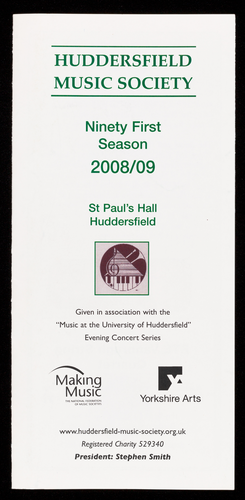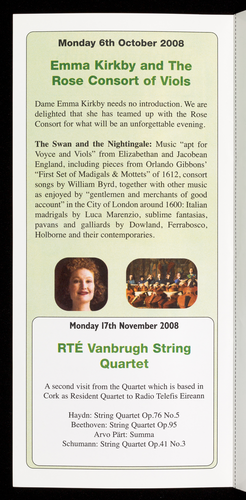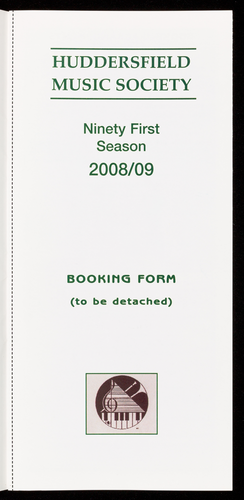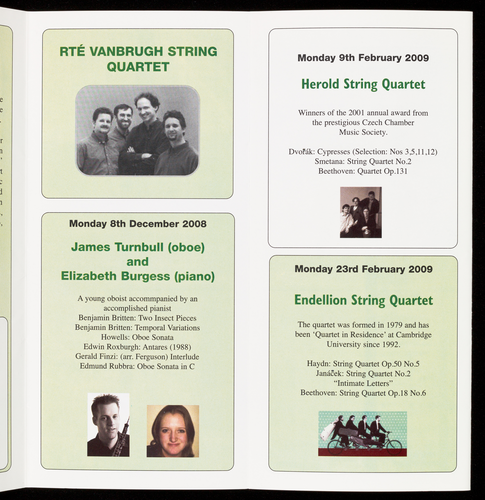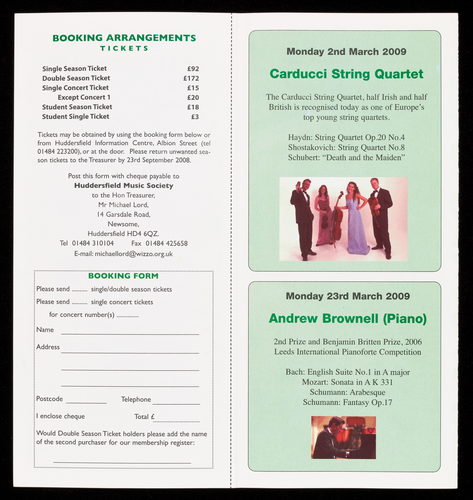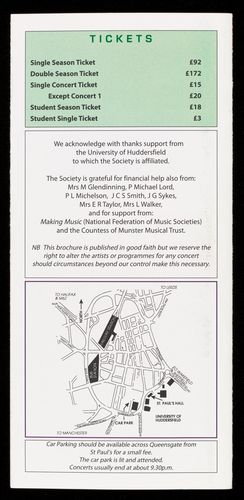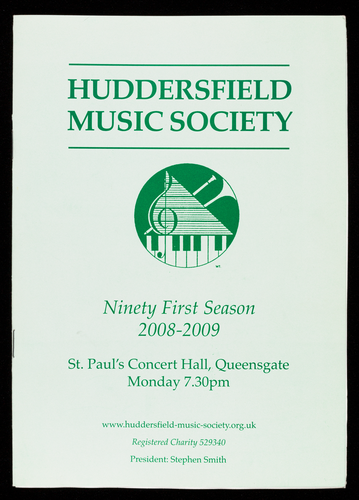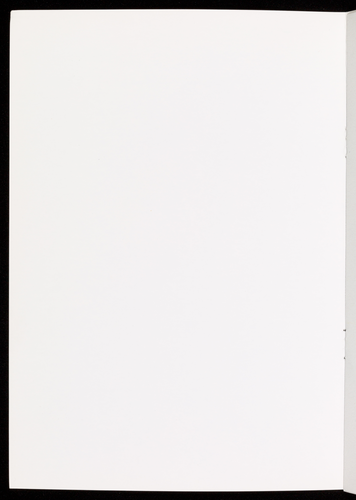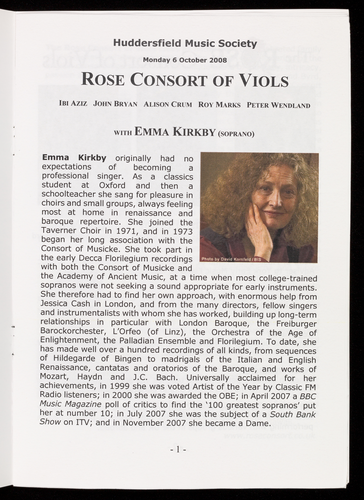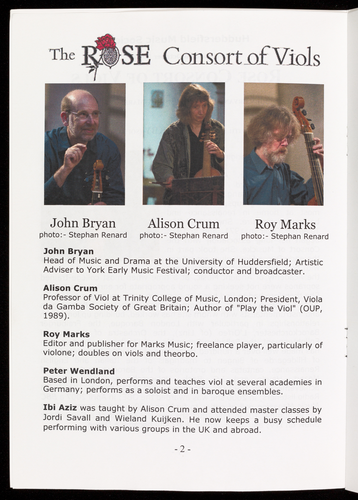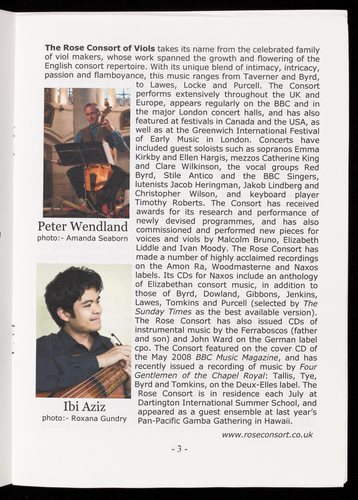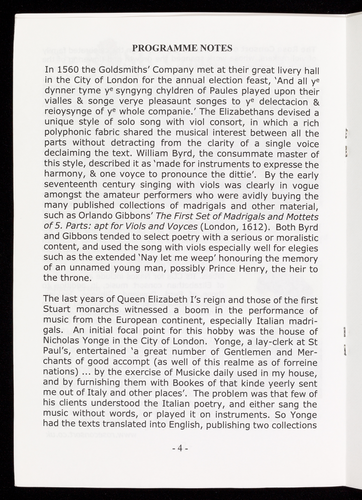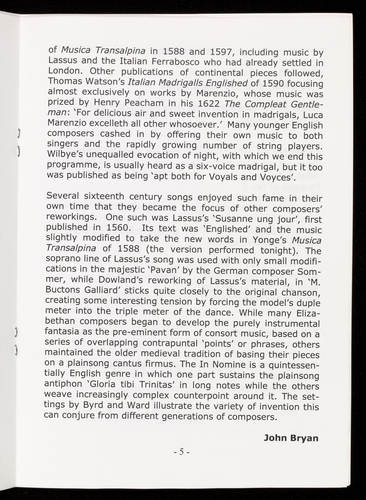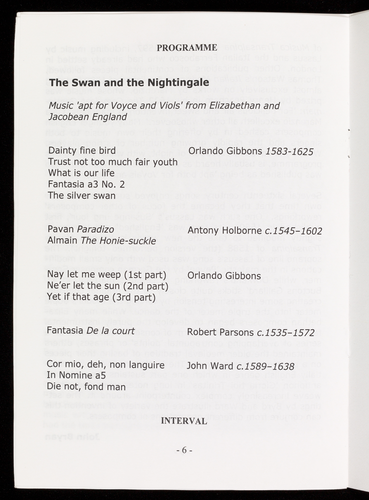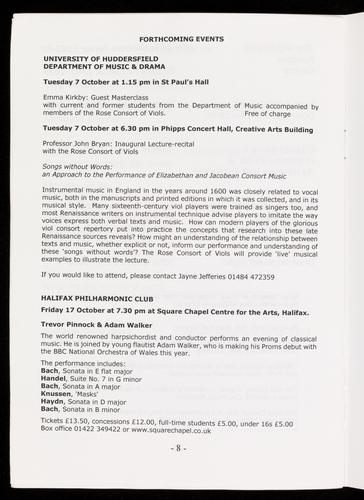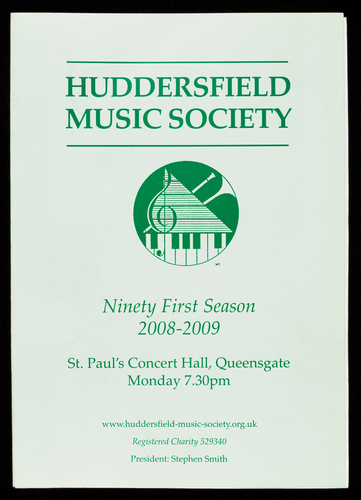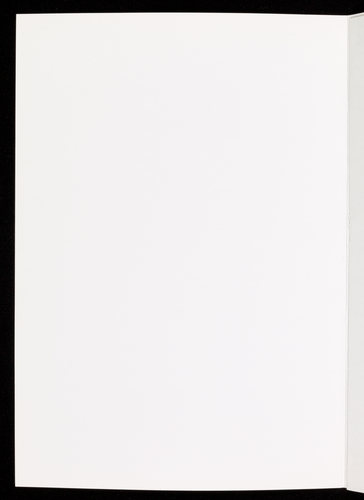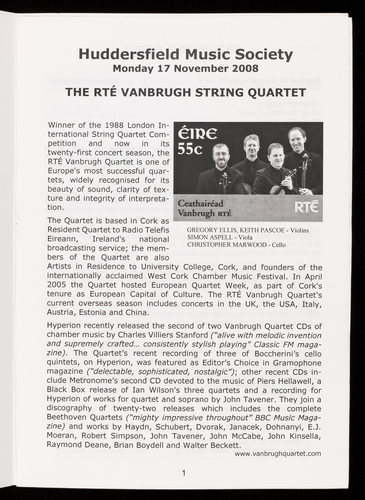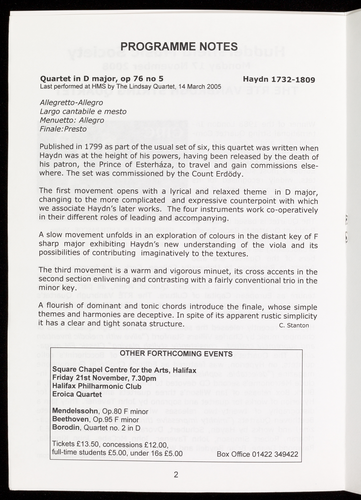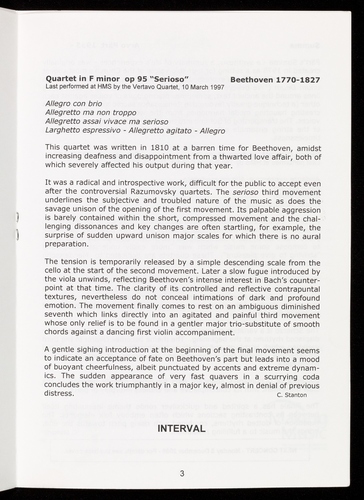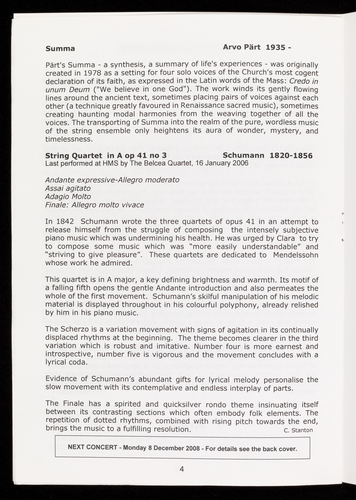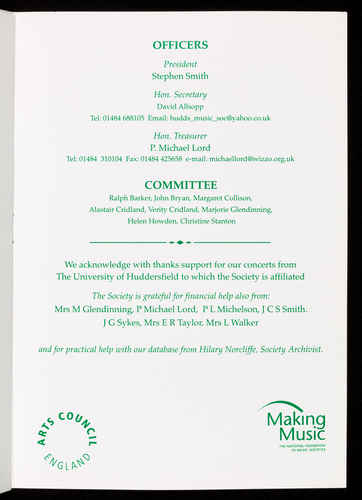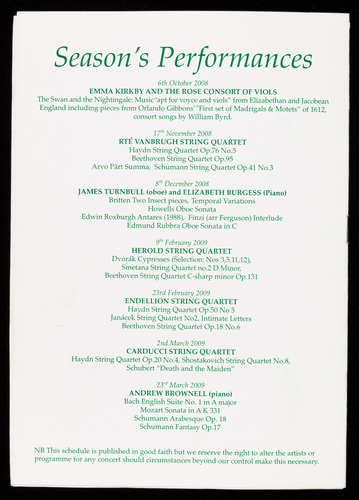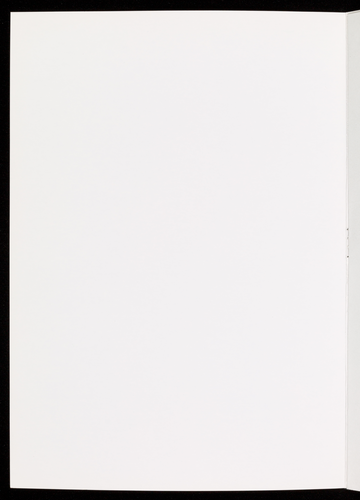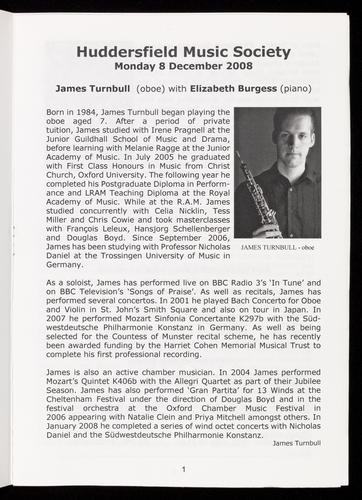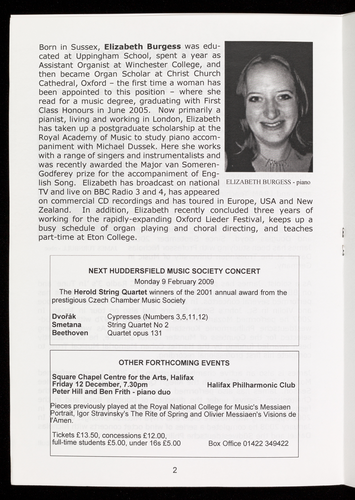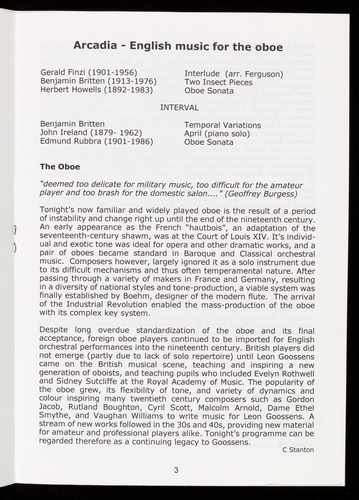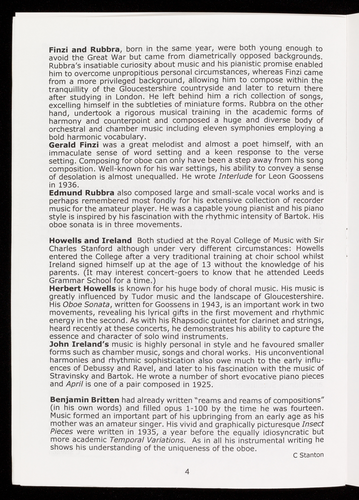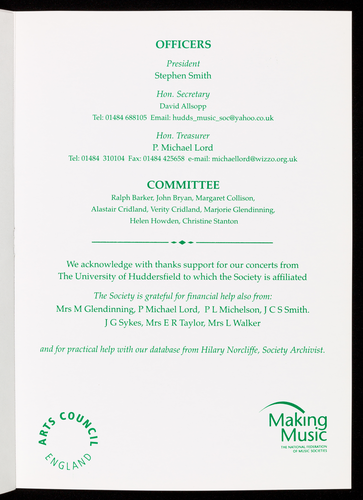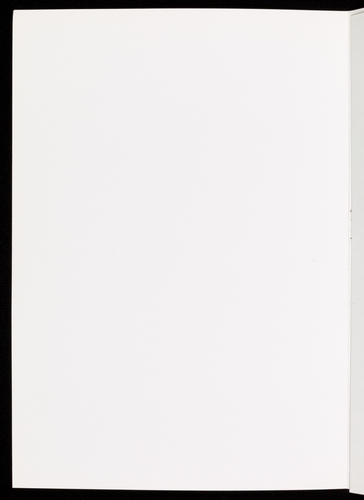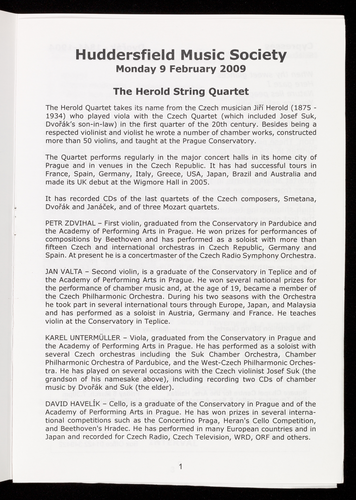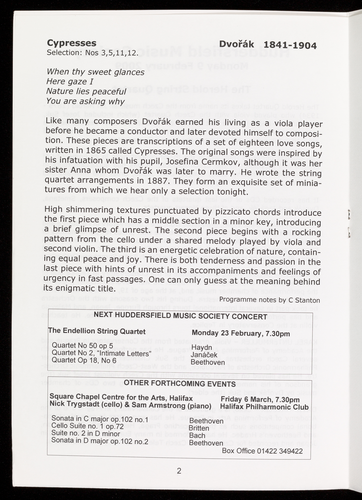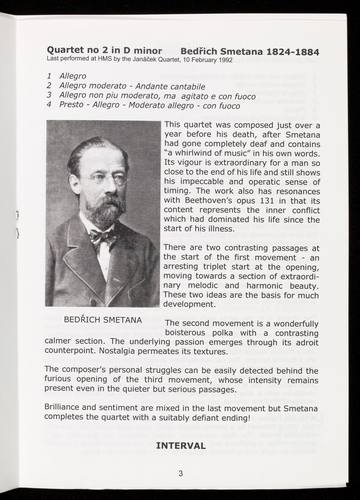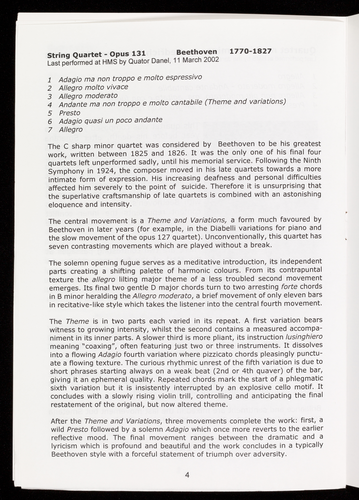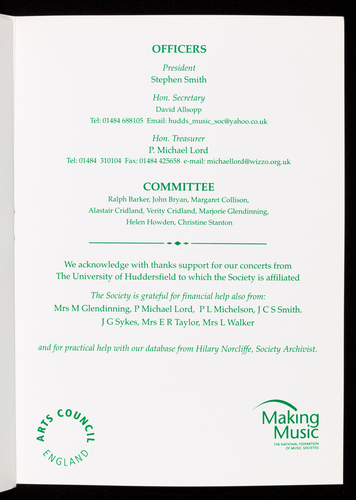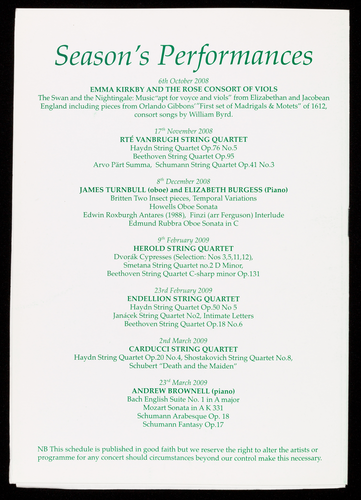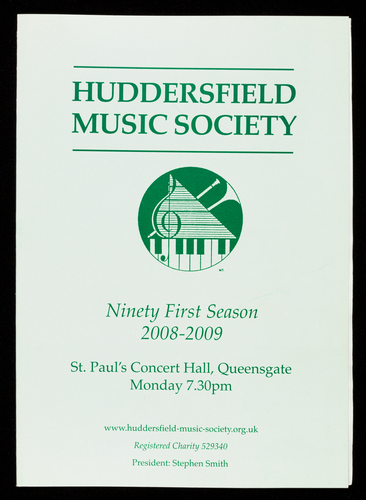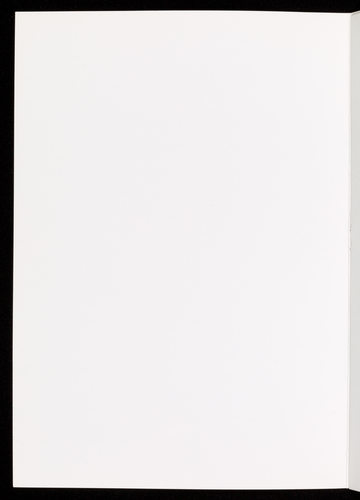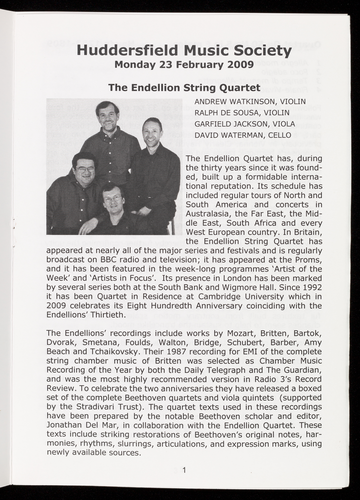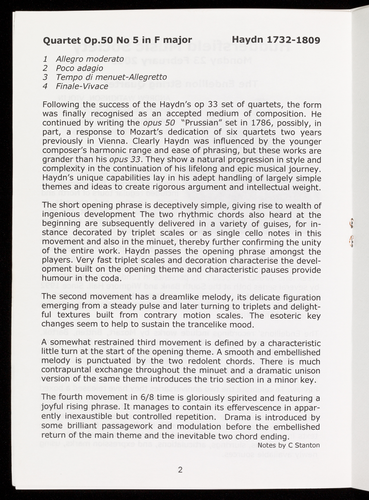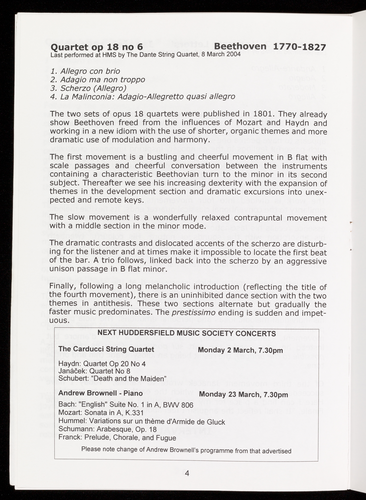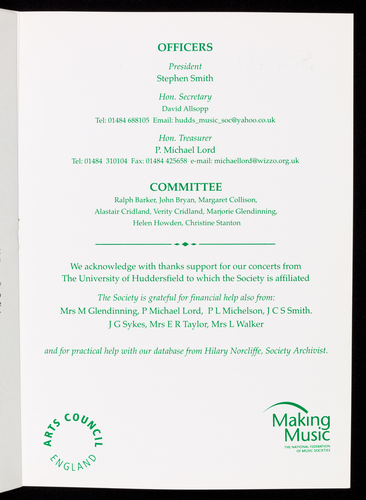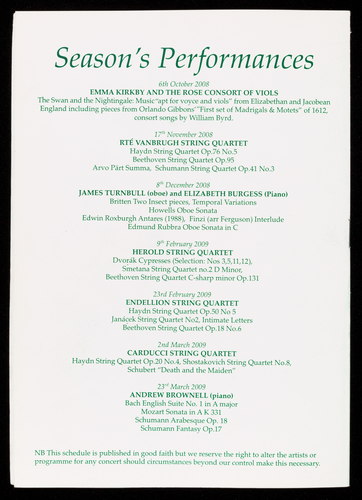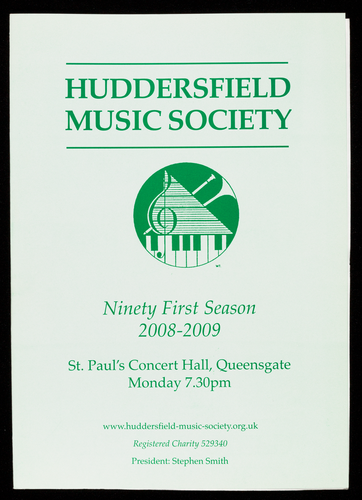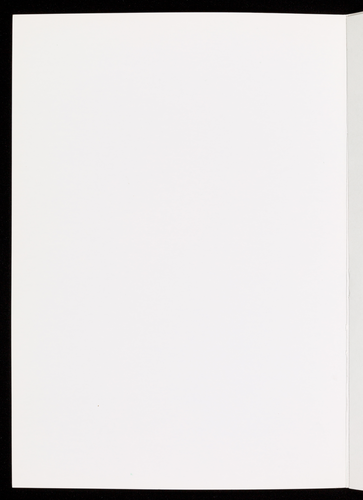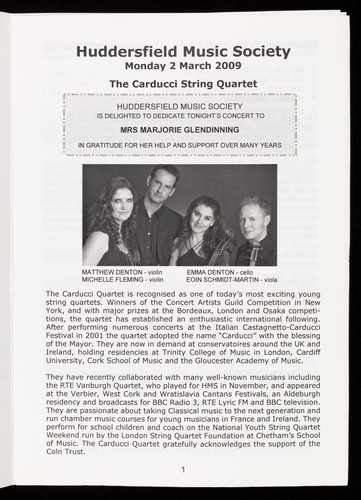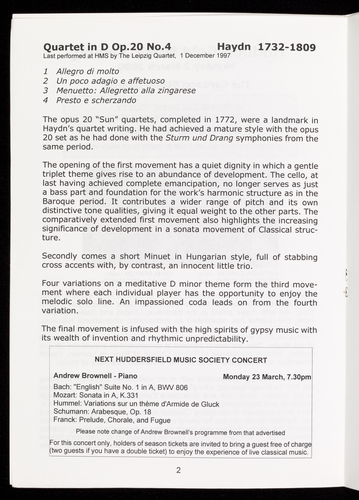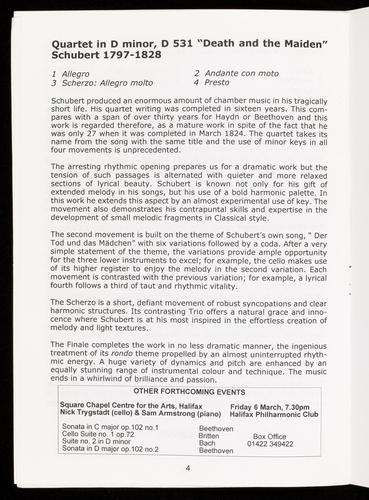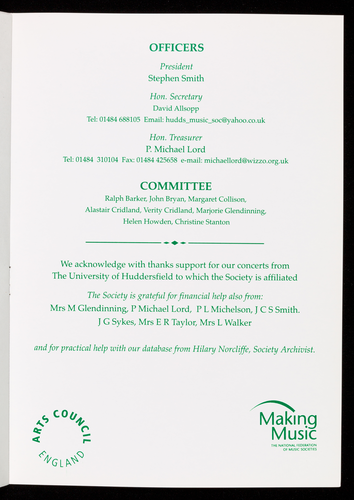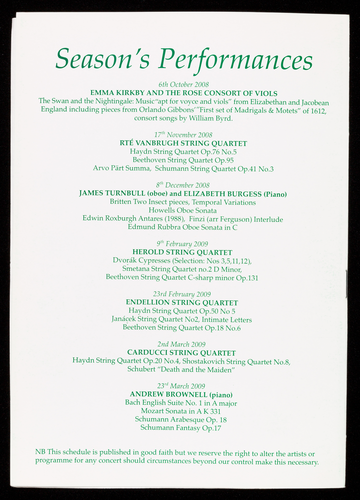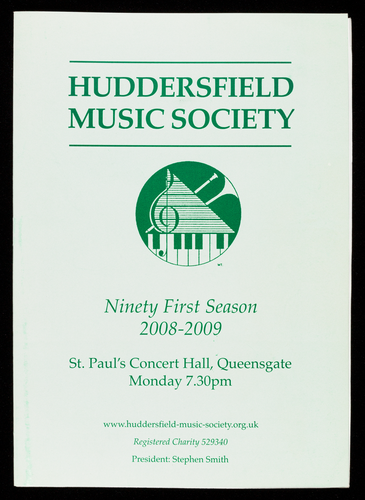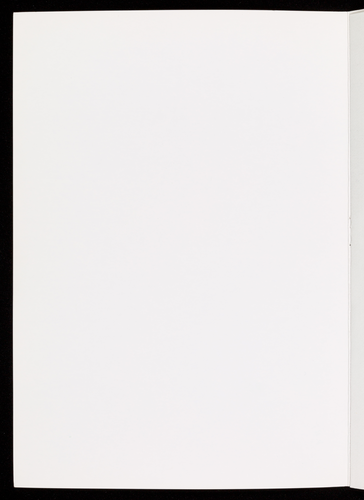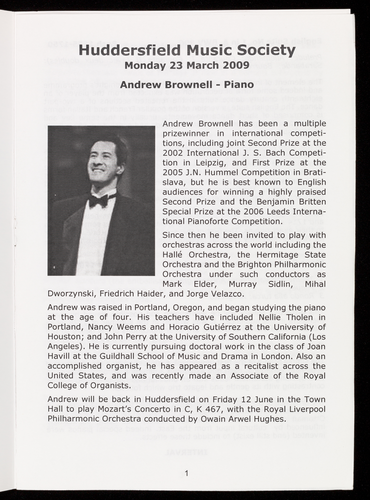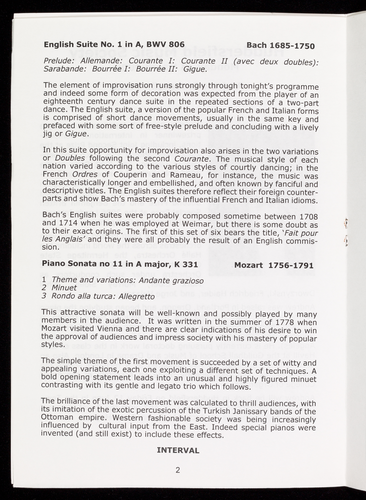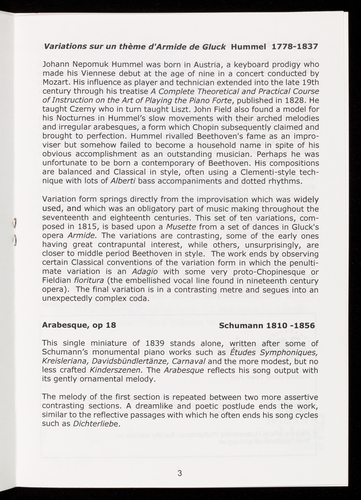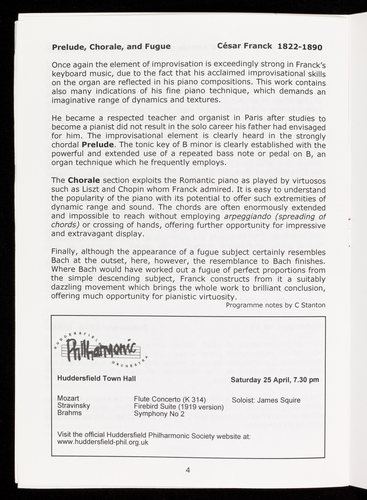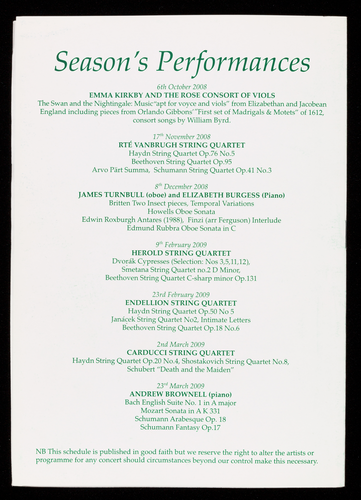Ocr'd Text:
HUDDERSFIELD
MUSIC SOCIETY
Ninety First
Season
2008/09
St Paul's Hall
Huddersfield
Given in association with the
"Music at the University of Huddersfield"
Evening Concert Series
Making
Music
THE NATIONAL FEDERATION
OF MUSIC SOCIETIES
D
Yorkshire Arts
www.huddersfield-music-society.org.uk
Registered Charity 529340
President: Stephen Smith
Ocr'd Text:
Monday 6th October 2008
Emma Kirkby and The
Rose Consort of Viols
Dame Emma Kirkby needs no introduction. We are
delighted that she has teamed up with the Rose
Consort for what will be an unforgettable evening.
The Swan and the Nightingale: Music "apt for
Voyce and Viols" from Elizabethan and Jacobean
England, including pieces from Orlando Gibbons'
"First Set of Madigals & Mottets" of 1612, consort
songs by William Byrd, together with other music
as enjoyed by "gentlemen and merchants of good
account" in the City of London around 1600: Italian
madrigals by Luca Marenzio, sublime fantasias,
pavans and galliards by Dowland, Ferrabosco,
Holborne and their contemporaries.
Monday 17th November 2008
RTÉ Vanbrugh String
Quartet
A second visit from the Quartet which is based in
Cork as Resident Quartet to Radio Telefis Eireann
Haydn: String Quartet Op.76 No.5
Beethoven: String Quartet Op.95
Arvo Pärt: Summa
Schumann: String Quartet Op.41 No.3
Ocr'd Text:
HUDDERSFIELD
MUSIC SOCIETY
Ninety First
Season
2008/09
BOOKING FORM
(to be detached)
望
T
Ocr'd Text:
e
e
r
n
t
C
d
1
RTÉ VANBRUGH STRING
QUARTET
to
Monday 8th December 2008
James Turnbull (oboe)
and
Elizabeth Burgess (piano)
A young oboist accommpanied by an
accomplished pianist
Benjamin Britten: Two Insect Pieces
Benjamin Britten: Temporal Variations
Howells: Oboe Sonata
Edwin Roxburgh: Antares (1988)
Gerald Finzi: (arr. Ferguson) Interlude
Edmund Rubbra: Oboe Sonata in C
Monday 9th February 2009
Herold String Quartet
Winners of the 2001 annual award from
the prestigious Czech Chamber
Music Society.
Dvořák: Cypresses (Selection: Nos 3,5,11,12)
Smetana: String Quartet No.2
Beethoven: Quartet Op.131
Monday 23rd February 2009
Endellion String Quartet
The quartet was formed in 1979 and has
been 'Quartet in Residence' at Cambridge
University since 1992.
Haydn: String Quartet Op.50 No.5
Janáček: String Quartet No.2
"Intimate Letters"
Beethoven: String Quartet Op.18 No.6
VA
Ocr'd Text:
BOOKING ARRANGEMENTS
Single Season Ticket
Double Season Ticket
Single Concert Ticket
Except Concert 1
Student Season Ticket
Student Single Ticket
Tickets may be obtained by using the booking form below or
from Huddersfield Information Centre, Albion Street (tel
01484 223200), or at the door. Please return unwanted sea-
son tickets to the Treasurer by 23rd September 2008.
TICKETS
Name
Address
Post this form with cheque payable to
Huddersfield Music Society
to the Hon Treasurer,
Mr Michael Lord,
14 Garsdale Road,
Newsome,
Tel 01484 310104
Postcode
Huddersfield HD4 6QZ.
BOOKING FORM
Please send ........... single/double season tickets
Please send .....…...
........ single concert tickets
for concert number(s)
E-mail: michaellord@wizzo.org.uk
I enclose cheque
Fax 01484 425658
...........
£92
£172
£15
£20
£18
£3
Telephone
Total £
Would Double Season Ticket holders please add the name
of the second purchaser for our membership register:
Monday 2nd March 2009
Carducci String Quartet
The Carducci String Quartet, half Irish and half
British is recognised today as one of Europe's
top young string quartets.
Haydn: String Quartet Op.20 No.4
Shostakovich: String Quartet No.8
Schubert: "Death and the Maiden"
Wit
Monday 23rd March 2009
Andrew Brownell (Piano)
2nd Prize and Benjamin Britten Prize, 2006
Leeds International Pianoforte Competition
Bach: English Suite No.1 in A major
Mozart: Sonata in A K 331
Schumann: Arabesque
Schumann: Fantasy Op.17
Ocr'd Text:
Single Season Ticket
Double Season Ticket
Single Concert Ticket
Except Concert 1
Student Season Ticket
Student Single Ticket
We acknowledge with thanks support from
the University of Huddersfield
to which the Society is affiliated.
The Society is grateful for financial help also from:
Mrs M Glendinning, P Michael Lord,
PL Michelson, JC S Smith, JG Sykes,
Mrs E R Taylor, Mrs L Walker,
and for support from:
Making Music (National Federation of Music Societies)
and the Countess of Munster Musical Trust.
TO HALIFAX
& M62
TICKETS
NB This brochure is published in good faith but we reserve the
right to alter the artists or programmes for any concert
should circumstances beyond our control make this necessary.
A629
NEW NORTH ROADO
TRINITY STREET
NORTH
CASTLE GATE
STATION
BUS
TO MANCHESTER
A62 MANCHESTER ROAD
RAILWAY STATION
SUD
1008
00G00
୦୦୮
001
O
A616 CHAPEL HILL
QUEESNGATE
CAR PARK
Car Parking should be available
QUEESN ST SOUTHO
SOUTHGATE
TO LEEDS
QUEEN
LEEDS ROAD A62
£92
£172
£15
£20
£18
£3
ST. PAUL'S HALL
TO WAKEFIELD
& SHEFFIELD
A629 WAKEFIELD ROAD
UNIVERSITY OF
HUDDERSFIELD
St Paul's for a small fee.
The car park is lit and attended.
Concerts usually end at about 9.30p.m.
across Queensgate from
Ocr'd Text:
HUDDERSFIELD
MUSIC SOCIETY
L
WT.
Ninety First Season
2008-2009
St. Paul's Concert Hall, Queensgate
Monday 7.30pm
www.huddersfield-music-society.org.uk
Registered Charity 529340
President: Stephen Smith
Ocr'd Text:
Huddersfield Music Society
Monday 6 October 2008
ROSE CONSORT OF VIOLS
IBI AZIZ JOHN BRYAN ALISON CRUM ROY MARKS PETER WENDLAND
WITH EMMA KIRKBY (SOPRANO)
Emma Kirkby originally had no
expectations of becoming a
professional singer. As a classics
student at
at Oxford and then a
schoolteacher she sang for pleasure in
choirs and small groups, always feeling
most at home in renaissance and
baroque repertoire. She joined the
Taverner Choir in 1971, and in 1973
began her long association with the
Consort of Musicke. She took part in
the early Decca Florilegium recordings Photo by David Kornfeld/BIS
with both the Consort of Musicke and
the Academy of Ancient Music, at a time when most college-trained
sopranos were not seeking a sound appropriate for early instruments.
She therefore had to find her own approach, with enormous help from
Jessica Cash in London, and from the many directors, fellow singers
and instrumentalists with whom she has worked, building up long-term
relationships in particular with London Baroque, the Freiburger
Barockorchester, L'Orfeo (of Linz), the Orchestra of the Age of
Enlightenment, the Palladian Ensemble and Florilegium. To date, she
has made well over a hundred recordings of all kinds, from sequences
of Hildegarde of Bingen to madrigals of the Italian and English
Renaissance, cantatas and oratorios of the Baroque, and works of
Mozart, Haydn and J.C. Bach. Universally acclaimed for her
achievements, in 1999 she was voted Artist of the Year by Classic FM
Radio listeners; in 2000 she was awarded the OBE; in April 2007 a BBC
Music Magazine poll of critics to find the '100 greatest sopranos' put
her at number 10; in July 2007 she was the subject of a South Bank
Show on ITV; and in November 2007 she became a Dame.
- 1 -
Ocr'd Text:
The ROSE
SE Consort of Viols
John Bryan
photo: Stephan Renard
John Bryan
Head of Music and Drama at the University of Huddersfield; Artistic
Adviser to York Early Music Festival; conductor and broadcaster.
Alison Crum
photo: - Stephan Renard
Alison Crum
Professor of Viol at Trinity College of Music, London; President, Viola
da Gamba Society of Great Britain; Author of "Play the Viol" (OUP,
1989).
Roy Marks
photo: - Stephan Renard
Roy Marks
Editor and publisher for Marks Music; freelance player, particularly of
violone; doubles on viols and theorbo.
Peter Wendland
Based in London, performs and teaches viol at several academies in
Germany; performs as a soloist and in baroque ensembles.
Ibi Aziz was taught by Alison Crum and attended master classes by
Jordi Savall and Wieland Kuijken. He now keeps a busy schedule
performing with various groups in the UK and abroad.
-2-
-
Ocr'd Text:
The Rose Consort of Viols takes its name from the celebrated family
of viol makers, whose work spanned the growth and flowering of the
English consort repertoire. With its unique blend of intimacy, intricacy,
passion and flamboyance, this music ranges from Taverner and Byrd,
to Lawes, Locke and Purcell. The Consort
performs extensively throughout the UK and
Europe, appears regularly on the BBC and in
the major London concert halls, and has also
featured at festivals in Canada and the USA, as
well as at the Greenwich International Festival
of Early Music in London. Concerts have
included guest soloists such as sopranos Emma
Kirkby and Ellen Hargis, mezzos Catherine King
and Clare Wilkinson, the vocal groups Red
Byrd, Stile Antico and the BBC Singers,
lutenists Jacob Heringman, Jakob Lindberg and
Christopher Wilson, and keyboard player
Timothy Roberts. The Consort has received
awards for its research and performance of
commissioned and performed new pieces for
newly devised programmes, and has also
voices and viols by Malcolm Bruno, Elizabeth
Liddle and Ivan Moody. The Rose Consort has
made a number of highly acclaimed recordings
on the Amon Ra, Woodmasterne and Naxos
labels. Its CDs for Naxos include an anthology
of Elizabethan consort music, in addition to
those of Byrd, Dowland, Gibbons, Jenkins,
Lawes, Tomkins and Purcell (selected by The
Sunday Times as the best available version).
The Rose Consort has also issued CDs of
instrumental music by the Ferraboscos (father
and son) and John Ward on the German label
cpo. The Consort featured on the cover CD of
the May 2008 BBC Music Magazine, and has
recently issued a recording of music by Four
Gentlemen of the Chapel Royal: Tallis, Tye,
Byrd and Tomkins, on the Deux-Elles label. The
Rose Consort is in residence each July at
Dartington International Summer School, and
appeared as a guest ensemble at last year's
Pan-Pacific Gamba Gathering in Hawaii.
www.roseconsort.co.uk
Peter Wendland
photo: - Amanda Seaborn
Ibi Aziz
photo: Roxana Gundry
-3-
Ocr'd Text:
PROGRAMME NOTES
In 1560 the Goldsmiths' Company met at their great livery hall
in the City of London for the annual election feast, 'And all ye
dynner tyme ye syngyng chyldren of Paules played upon their
vialles & songe verye pleasaunt songes to ye delectacion &
reioysynge of ye whole companie.' The Elizabethans devised a
unique style of solo song with viol consort, in which a rich
polyphonic fabric shared the musical interest between all the
parts without detracting from the clarity of a single voice.
declaiming the text. William Byrd, the consummate master of
this style, described it as 'made for instruments to expresse the
harmony, & one voyce to pronounce the dittie'. By the early
seventeenth century singing with viols was clearly in vogue
amongst the amateur performers who were avidly buying the
many published collections of madrigals and other material,
such as Orlando Gibbons' The First Set of Madrigals and Mottets
of 5. Parts: apt for Viols and Voyces (London, 1612). Both Byrd
and Gibbons tended to select poetry with a serious or moralistic
content, and used the song with viols especially well for elegies
such as the extended 'Nay let me weep' honouring the memory
of an unnamed young man, possibly Prince Henry, the heir to
the throne.
The last years of Queen Elizabeth I's reign and those of the first
Stuart monarchs witnessed a boom in the performance of
music from the European continent, especially Italian madri-
gals. An initial focal point for this hobby was the house of
Nicholas Yonge in the City of London. Yonge, a lay-clerk at St.
Paul's, entertained a great number of Gentlemen and Mer-
chants of good accompt (as well of this realme as of forreine
nations) ... by the exercise of Musicke daily used in my house,
and by furnishing them with Bookes of that kinde yeerly sent.
me out of Italy and other places'. The problem was that few of
his clients understood the Italian poetry, and either sang the
music without words, or played it on instruments. So Yonge
had the texts translated into English, publishing two collections
- 4-
-
A
Ocr'd Text:
}
}
2
1
of Musica Transalpina in 1588 and 1597, including music by
Lassus and the Italian Ferrabosco who had already settled in
London. Other publications of continental pieces followed,
Thomas Watson's Italian Madrigalls Englished of 1590 focusing
almost exclusively on works by Marenzio, whose music was
prized by Henry Peacham in his 1622 The Compleat Gentle-
man: 'For delicious air and sweet invention in madrigals, Luca
Marenzio excelleth all other whosoever.' Many younger English
composers cashed in by offering their own music to both
singers and the rapidly growing number of string players.
Wilbye's unequalled evocation of night, with which we end this
programme, is usually heard as a six-voice madrigal, but it too
was published as being 'apt both for Voyals and Voyces'.
Several sixteenth century songs enjoyed such fame in their
own time that they became the focus of other composers'
reworkings. One such was Lassus's 'Susanne ung jour', first
published in 1560. Its text was 'Englished' and the music
slightly modified to take the new words in Yonge's Musica
Transalpina of 1588 (the version performed tonight). The
soprano line of Lassus's song was used with only small modifi-
cations in the majestic 'Pavan' by the German composer Som-
mer, while Dowland's reworking of Lassus's material, in 'M.
Buctons Galliard' sticks quite closely to the original chanson,
creating some interesting tension by forcing the model's duple
meter into the triple meter of the dance. While many Eliza-
bethan composers began to develop the purely instrumental
fantasia as the pre-eminent form of consort music, based on a
series of overlapping contrapuntal 'points' or phrases, others
maintained the older medieval tradition of basing their pieces
on a plainsong cantus firmus. The In Nomine is a quintessen-
tially English genre in which one part sustains the plainsong
antiphon 'Gloria tibi Trinitas' in long notes while the others.
weave increasingly complex counterpoint around it. The set-
tings by Byrd and Ward illustrate the variety of invention this
can conjure from different generations of composers.
-5-
-
John Bryan
Ocr'd Text:
The Swan and the Nightingale
Music 'apt for Voyce and Viols' from Elizabethan and
Jacobean England
PROGRAMME
Dainty fine bird
Trust not too much fair youth
What is our life
Fantasia a3 No. 2
The silver swan
Pavan Paradizo
Almain The Honie-suckle
Nay let me weep (1st part)
Ne'er let the sun (2nd part)
Yet if that age (3rd part)
Fantasia De la court
Cor mio, deh, non languire
In Nomine a5
Die not, fond man
Orlando Gibbons 1583-1625
Antony Holborne c.1545-1602
Orlando Gibbons
Robert Parsons c.1535-1572
John Ward c. 1589-1638
INTERVAL
-6-
Ocr'd Text:
The Nightingale
Fantasia
Cuckoo
Alfonso Ferrabosco senior 1543-88
Evr'y singing Byrd hemminged
Dolorous mournful cares
O Lord how vain
In Nomine a5 No. 4
My mistress had a little dog
Pavan (on Susanne un jour)
Susanna fayre
M. Buctons Galliard
Draw on sweet night
Richard Nicholson 1563-1639
Luca Marenzio 1553/4-1599
William Byrd c. 1540-1623 diw
Johann Sommer d. 1627
Orlando Lassus 1532-1594
John Dowland 1563-1626
John Wilbye 1574-1628
Rose Consort of Viols' latest CD: Four Gentlemen of the Chapel
Royal with Clare Wilkinson (mezzo)
Deux-Elles DXL 1129
Music by Tallis, Tye, Byrd and Tomkins
an attractively varied selection of vocal and instrumental music ... that all
works extremely well' Goldberg
The Rose Consort, one of our top viol consorts, is in expressive and ele-
gant form' www.musicweb-international
The viol playing is good ... delicately shaped ... a musical and experi-
enced ensemble' BBC Music Magazine
the Rose Consort play in a sublimely unfussy, unfettered manner worthy
of the music' Gramophone
-7-
Ocr'd Text:
FORTHCOMING EVENTS
UNIVERSITY OF HUDDERSFIELD
DEPARTMENT OF MUSIC & DRAMA
Tuesday 7 October at 1.15 pm in St Paul's Hall
Emma Kirkby: Guest Masterclass
with current and former students from the Department of Music accompanied by
members of the Rose Consort of Viols.
Free of charge
Tuesday 7 October at 6.30 pm in Phipps Concert Hall, Creative Arts Building
Professor John Bryan: Inaugural Lecture-recital
with the Rose Consort of Viols
Songs without Words:
an Approach to the Performance of Elizabethan and Jacobean Consort Music
strumental music in England in the years around 1600 was closely related to vocal
music, both in the manuscripts and printed editions in which it was collected, and in its
musical style. Many sixteenth-century viol players were trained as singers too, and
most Renaissance writers on instrumental technique advise players to imitate the way
voices express both verbal texts and music. How can modern players of the glorious
viol consort repertory put into practice the concepts that research into these late
Renaissance sources reveals? How might an understanding of the relationship between
texts and music, whether explicit or not, inform our performance and understanding of
these 'songs without words'? The Rose Consort of Viols will provide 'live' musical
examples to illustrate the lecture.
If you would like to attend, please contact Jayne Jefferies 01484 472359
HALIFAX PHILHARMONIC CLUB
Friday 17 October at 7.30 pm at Square Chapel Centre for the Arts, Halifax.
Trevor Pinnock & Adam Walker
The world renowned harpsichordist and conductor performs an evening of classical
music. He is joined by young flautist Adam Walker, who is making his Proms debut with
the BBC National Orchestra of Wales this year.
The performance includes:
Bach, Sonata in E flat major
Handel, Suite No. 7 in G minor
Bach, Sonata in A major
Knussen, 'Masks'
Haydn, Sonata in D major
Bach, Sonata in B minor
Tickets £13.50, concessions £12.00, full-time students £5.00, under 16s £5.00
Box office 01422 349422 or www.squarechapel.co.uk
-8-
Ocr'd Text:
ARTS
OFFICERS
President
Stephen Smith
Hon. Secretary
David Allsopp
Tel: 01484 688105 Email: hudds_music_soc@yahoo.co.uk
Hon. Treasurer
P. Michael Lord
Tel: 01484 310104 Fax: 01484 425658 e-mail: michaellord@wizzo.org.uk
COMMITTEE
Ralph Barker, John Bryan, Margaret Collison,
Alastair Cridland, Verity Cridland, Marjorie Glendinning,
Helen Howden, Christine Stanton
We acknowledge with thanks support for our concerts from
The University of Huddersfield to which the Society is affiliated
The Society is grateful for financial help also from:
Mrs M Glendinning, P Michael Lord, P L Michelson, J C S Smith.
JG Sykes, Mrs E R Taylor, Mrs L Walker
and for practical help with our database from Hilary Norcliffe, Society Archivist.
ENGLAND
COUNCIL
Making
Music
THE NATIONAL FEDERATION
OF MUSIC SOCIETIES
Ocr'd Text:
Season's Performances
6th October 2008
EMMA KIRKBY AND THE ROSE CONSORT OF VIOLS
The Swan and the Nightingale: Music"apt for voyce and viols" from Elizabethan and Jacobean
England including pieces from Orlando Gibbons" "First set of Madrigals & Motets" of 1612,
consort songs by William Byrd.
17th November 2008
RTÉ VANBRUGH STRING QUARTET
Haydn String Quartet Op.76 No.5
Beethoven String Quartet Op.95
Arvo Pärt Summa, Schumann String Quartet Op.41 No.3
8th December 2008
JAMES TURNBULL (oboe) and ELIZABETH BURGESS (Piano)
Britten Two Insect pieces, Temporal Variations
Howells Oboe Sonata
Edwin Roxburgh Antares (1988), Finzi (arr Ferguson) Interlude
Edmund Rubbra Oboe Sonata in C
9th February 2009
HEROLD STRING QUARTET
Dvorák Cypresses (Selection: Nos 3,5,11,12),
Smetana String Quartet no.2 D Minor,
Beethoven String Quartet C-sharp minor Op.131
23rd February 2009
ENDELLION STRING QUARTET
Haydn String Quartet Op.50 No 5
Janácek String Quartet No2, Intimate Letters
Beethoven String Quartet Op.18 No.6
2nd March 2009
CARDUCCI STRING QUARTET
Haydn String Quartet Op.20 No.4, Shostakovich String Quartet No.8,
Schubert "Death and the Maiden"
23rd March 2009
ANDREW BROWNELL (piano)
Bach English Suite No. 1 in A major
Mozart Sonata in A K 331
Schumann Arabesque Op. 18
Schumann Fantasy Op.17
NB This schedule is published in good faith but we reserve the right to alter the artists or
programme for any concert should circumstances beyond our control make this necessary.
Ocr'd Text:
HUDDERSFIELD
MUSIC SOCIETY
LL
WT.
Ninety First Season
2008-2009
St. Paul's Concert Hall, Queensgate
Monday 7.30pm
www.huddersfield-music-society.org.uk
Registered Charity 529340
President: Stephen Smith
Ocr'd Text:
Huddersfield Music Society
Monday 17 November 2008
THE RTÉ VANBRUGH STRING QUARTET
Winner of the 1988 London In-
ternational String Quartet Com- ÉIRE
55c
petition and now in its
twenty-first concert season, the
RTÉ Vanbrugh Quartet is one of
Europe's most successful quar-
tets, widely recognised for its
beauty of sound, clarity of tex-
ture and integrity of interpreta-
tion.
Ceathairéad
Vanbrugh RTÉ
RTE
GREGORY ELLIS, KEITH PASCOE - Violins
SIMON ASPELL - Viola
CHRISTOPHER MARWOOD - Cello
The Quartet is based in Cork as
Resident Quartet to Radio Telefis
Eireann, Ireland's national
broadcasting service; the mem-
bers of the Quartet are also
Artists in Residence to University College, Cork, and founders of the
internationally acclaimed West Cork Chamber Music Festival. In April
2005 the Quartet hosted European Quartet Week, as part of Cork's
tenure as European Capital of Culture. The RTÉ Vanbrugh Quartet's
current overseas season includes concerts in the UK, the USA, Italy,
Austria, Estonia and China.
Hyperion recently released the second of two Vanbrugh Quartet CDs of
chamber music by Charles Villiers Stanford ("alive with melodic invention
and supremely crafted... consistently stylish playing" Classic FM maga-
zine). The Quartet's recent recording of three of Boccherini's cello
quintets, on Hyperion, was featured as Editor's Choice in Gramophone
magazine ("delectable, sophisticated, nostalgic"); other recent CDs in-
clude Metronome's second CD devoted to the music of Piers Hellawell, a
Black Box release of Ian Wilson's three quartets and a recording for
Hyperion of works for quartet and soprano by John Tavener. They join a
discography of twenty-two releases which includes the complete
Beethoven Quartets ("mighty impressive throughout" BBC Music Maga-
zine) and works by Haydn, Schubert, Dvorak, Janacek, Dohnanyi, E.J.
Moeran, Robert Simpson, John Tavener, John McCabe, John Kinsella,
Raymond Deane, Brian Boydell and Walter Beckett.
www.vanbrughquartet.com
1
Ocr'd Text:
PROGRAMME NOTES
Quartet in D major, op 76 no 5
Last performed at HMS by The Lindsay Quartet, 14 March 2005
Allegretto-Allegro
Largo cantabile e mesto
Menuetto: Allegro
Finale: Presto
Published in 1799 as part of the usual set of six, this quartet was written when
Haydn was at the height of his powers, having been released by the death of
his patron, the Prince of Esterháza, to travel and gain commissions else-
where. The set was commissioned by the Count Erdödy.
The first movement opens with a lyrical and relaxed theme in D major,
changing to the more complicated and expressive counterpoint with which
we associate Haydn's later works. The four instruments work co-operatively
in their different roles of leading and accompanying.
A slow movement unfolds in an exploration of colours in the distant key of F
sharp major exhibiting Haydn's new understanding of the viola and its
possibilities of contributing imaginatively to the textures.
The third movement is a warm and vigorous minuet, its cross accents in the
second section enlivening and contrasting with a fairly conventional trio in the
minor key.
Haydn 1732-1809
A flourish of dominant and tonic chords introduce the finale, whose simple
themes and harmonies are deceptive. In spite of its apparent rustic simplicity
it has a clear and tight sonata structure.
C. Stanton
OTHER FORTHCOMING EVENTS
Square Chapel Centre for the Arts, Halifax
Friday 21st November, 7.30pm
Halifax Philharmonic Club
Eroica Quartet
Mendelssohn, Op.80 F minor
Beethoven, Op.95 F minor
Borodin, Quartet no. 2 in D
Tickets £13.50, concessions £12.00, Cons
full-time students £5.00, under 16s £5.00
2
Box Office 01422 349422
Ocr'd Text:
3
)
Quartet in F minor op 95 "Serioso"
Last performed at HMS by the Vertavo Quartet, 10 March 1997
Allegro con brio
Allegretto ma non troppo
Allegretto assai vivace ma serioso
Larghetto espressivo - Allegretto agitato - Allegro
This quartet was written in 1810 at a barren time for Beethoven, amidst
increasing deafness and disappointment from a thwarted love affair, both of
which severely affected his output during that year.
Beethoven 1770-1827
It was a radical and introspective work, difficult for the public to accept even
after the controversial Razumovsky quartets. The serioso third movement
underlines the subjective and troubled nature of the music as does the
savage unison of the opening of the first movement. Its palpable aggression
is barely contained within the short, compressed movement and the chal-
lenging dissonances and key changes are often startling, for example, the
surprise of sudden upward unison major scales for which there is no aural
preparation.
The tension is temporarily released by a simple descending scale from the
cello at the start of the second movement. Later a slow fugue introduced by
the viola unwinds, reflecting Beethoven's intense interest in Bach's counter-
point at that time. The clarity of its controlled and reflective contrapuntal
textures, nevertheless do not conceal intimations of dark and profound
emotion. The movement finally comes to rest on an ambiguous diminished
seventh which links directly into an agitated and painful third movement
whose only relief is to be found in a gentler major trio-substitute of smooth
chords against a dancing first violin accompaniment.
A gentle sighing introduction at the beginning of the final movement seems
to indicate an acceptance of fate on Beethoven's part but leads into a mood
of buoyant cheerfulness, albeit punctuated by accents and extreme dynam-
ics. The sudden appearance of very fast quavers in a scurrying coda
concludes the work triumphantly in a major key, almost in denial of previous
distress.
C. Stanton
INTERVAL
3
Ocr'd Text:
Summa
Pärt's Summa - a synthesis, a summary of life's experiences - was originally
created in 1978 as a setting for four solo voices of the Church's most cogent
declaration of its faith, as expressed in the Latin words of the Mass: Credo in
unum Deum ("We believe in one God"). The work winds its gently flowing
lines around the ancient text, sometimes placing pairs of voices against each
other (a technique greatly favoured in Renaissance sacred music), sometimes
creating haunting modal harmonies from the weaving together of all the
voices. The transporting of Summa into the realm of the pure, wordless music
of the string ensemble only heightens its aura of wonder, mystery, and
timelessness.
Arvo Pärt 1935-
Andante expressive-Allegro moderato
Assai agitato
Adagio Molto
Finale: Allegro molto vivace
String Quartet in A op 41 no 3
Last performed at HMS by The Belcea Quartet, 16 January 2006
Schumann 1820-1856
In 1842 Schumann wrote the three quartets of opus 41 in an attempt to
release himself from the struggle of composing the intensely subjective
piano music which was undermining his health. He was urged by Clara to try
to compose some music which was "more easily understandable" and
"striving to give pleasure". These quartets are dedicated to Mendelssohn
whose work he admired.
This quartet is in A major, a key defining brightness and warmth. Its motif of
a falling fifth opens the gentle Andante introduction and also permeates the
whole of the first movement. Schumann's skilful manipulation of his melodic
material is displayed throughout in his colourful polyphony, already relished
by him in his piano music.
The Scherzo is a variation movement with signs of agitation in its continually
displaced rhythms at the beginning. The theme becomes clearer in the third
variation which is robust and imitative. Number four is more earnest and
introspective, number five is vigorous and the movement concludes with a
lyrical coda.
Evidence of Schumann's abundant gifts for lyrical melody personalise the
slow movement with its contemplative and endless interplay of parts.
The Finale has a spirited and quicksilver rondo theme insinuating itself
between its contrasting sections which often embody folk elements. The
repetition of dotted rhythms, combined with rising pitch towards the end,
brings the music to a fulfilling resolution.
C. Stanton
4
NEXT CONCERT - Monday 8 December 2008 - For details see the back cover.
1
Ocr'd Text:
OFFICERS
President
Stephen Smith
Hon. Secretary
David Allsopp
Tel: 01484 688105 Email: hudds_music_soc@yahoo.co.uk
Hon. Treasurer
P. Michael Lord
Tel: 01484 310104 Fax: 01484 425658 e-mail: michaellord@wizzo.org.uk
COMMITTEE
Ralph Barker, John Bryan, Margaret Collison,
Alastair Cridland, Verity Cridland, Marjorie Glendinning,
Helen Howden, Christine Stanton
We acknowledge with thanks support for our concerts from
The University of Huddersfield to which the Society is affiliated
ARTS
The Society is grateful for financial help also from:
Mrs M Glendinning, P Michael Lord, P L Michelson, J C S Smith.
JG Sykes, Mrs E R Taylor, Mrs L Walker
and for practical help with our database from Hilary Norcliffe, Society Archivist.
COUNCIL
ENGLAND
Making
Music
THE NATIONAL FEDERATION
OF MUSIC SOCIETIES
Ocr'd Text:
Season's Performances
6th October 2008
EMMA KIRKBY AND THE ROSE CONSORT OF VIOLS
The Swan and the Nightingale: Music"apt for voyce and viols" from Elizabethan and Jacobean
England including pieces from Orlando Gibbons "First set of Madrigals & Motets" of 1612,
consort songs by William Byrd.
17th November 2008
RTÉ VANBRUGH STRING QUARTET
Haydn String Quartet Op.76 No.5
Beethoven String Quartet Op.95
Arvo Pärt Summa, Schumann String Quartet Op.41 No.3
8th December 2008
JAMES TURNBULL (oboe) and ELIZABETH BURGESS (Piano)
Britten Two Insect pieces, Temporal Variations
Howells Oboe Sonata
Edwin Roxburgh Antares (1988), Finzi (arr Ferguson) Interlude
Edmund Rubbra Oboe Sonata in C
9th February 2009
HEROLD STRING QUARTET
Dvorák Cypresses (Selection: Nos 3,5,11,12),
Smetana String Quartet no.2 D Minor,
Beethoven String Quartet C-sharp minor Op.131
23rd February 2009
ENDELLION STRING QUARTET
Haydn String Quartet Op.50 No 5
Janácek String Quartet No2, Intimate Letters
Beethoven String Quartet Op.18 No.6
2nd March 2009
CARDUCCI STRING QUARTET
Haydn String Quartet Op.20 No.4, Shostakovich String Quartet No.8,
Schubert "Death and the Maiden"
23rd March 2009
ANDREW BROWNELL (piano)
Bach English Suite No. 1 in A major
Mozart Sonata in A K 331
Schumann Arabesque Op. 18
Schumann Fantasy Op.17
NB This schedule is published in good faith but we reserve the right to alter the artists or
programme for any concert should circumstances beyond our control make this necessary.
Ocr'd Text:
HUDDERSFIELD
MUSIC SOCIETY
||
WT.
Ninety First Season
2008-2009
St. Paul's Concert Hall, Queensgate
Monday 7.30pm
www.huddersfield-music-society.org.uk
Registered Charity 529340
President: Stephen Smith
Ocr'd Text:
Huddersfield Music Society
Monday 8 December 2008
James Turnbull (oboe) with Elizabeth Burgess (piano)
Born in 1984, James Turnbull began playing the
oboe aged 7. After a period of private
tuition, James studied with Irene Pragnell at the
Junior Guildhall School of Music and Drama,
before learning with Melanie Ragge at the Junior
Academy of Music. In July 2005 he graduated
with First Class Honours in Music from Christ
Church, Oxford University. The following year he
completed his Postgraduate Diploma in Perform-
ance and LRAM Teaching Diploma at the Royal
Academy of Music. While at the R.A.M. James
studied concurrently with Celia Nicklin, Tess
Miller and Chris Cowie and took masterclasses
with François Leleux, Hansjorg Schellenberger
and Douglas Boyd. Since September 2006,
James has been studying with Professor Nicholas JAMES TURNBULL - oboe
Daniel at the Trossingen University of Music in
Germany.
24
As a soloist, James has performed live on BBC Radio 3's 'In Tune' and
on BBC Television's 'Songs of Praise'. As well as recitals, James has
performed several concertos. In 2001 he played Bach Concerto for Oboe
and Violin in St. John's Smith Square and also on tour in Japan. In
2007 he performed Mozart Sinfonia Concertante K297b with the Süd-
westdeutsche Philharmonie Konstanz in Germany. As well as being
selected for the Countess of Munster recital scheme, he has recently
been awarded funding by the Harriet Cohen Memorial Musical Trust to
complete his first professional recording.
James is also an active chamber musician. In 2004 James performed
Mozart's Quintet K406b with the Allegri Quartet as part of their Jubilee
Season. James has also performed 'Gran Partita' for 13 Winds at the
Cheltenham Festival under the direction of Douglas Boyd and in the
festival orchestra at the Oxford Chamber Music Festival in
2006 appearing with Natalie Clein and Priya Mitchell amongst others. In
January 2008 he completed a series of wind octet concerts with Nicholas
Daniel and the Südwestdeutsche Philharmonie Konstanz.
1
James Turnbull
Ocr'd Text:
Born in Sussex, Elizabeth Burgess was edu-
cated at Uppingham School, spent a year as
Assistant Organist at Winchester College, and
then became Organ Scholar at Christ Church
Cathedral, Oxford - the first time a woman has
been appointed to this position where she
read for a music degree, graduating with First
Class Honours in June 2005. Now primarily a
pianist, living and working in London, Elizabeth
has taken up a postgraduate scholarship at the
Royal Academy of Music to study piano accom-
paniment with Michael Dussek. Here she works
with a range of singers and instrumentalists and
was recently awarded the Major van Someren-
Godferey prize for the accompaniment of Eng-
lish Song. Elizabeth has broadcast on national ELIZABETH BURGESS - piano
TV and live on BBC Radio 3 and 4, has appeared
on commercial CD recordings and has toured in Europe, USA and New
Zealand. In addition, Elizabeth recently concluded three years of
working for the rapidly-expanding Oxford Lieder Festival, keeps up a
busy schedule of organ playing and choral directing, and teaches
part-time at Eton College.
-
NEXT HUDDERSFIELD MUSIC SOCIETY CONCERT
Monday 9 February 2009
The Herold String Quartet winners of the 2001 annual award from the
500 prestigious Czech Chamber Music Society
Dvořák
Smetana
Beethoven
Cypresses (Numbers 3,5,11,12)
String Quartet No 2
Quartet opus 131
OTHER FORTHCOMING EVENTS
Square Chapel Centre for the Arts, Halifax
Friday 12 December, 7.30pm
Peter Hill and Ben Frith - piano duo
Pieces previously played at the Royal National College for Music's Messiaen
Portrait, Igor Stravinsky's The Rite of Spring and Olivier Messiaen's Visions de
l'Amen.
Tickets £13.50, concessions £12.00,
full-time students £5.00, under 16s £5.00
Halifax Philharmonic Club
2
Box Office 01422 349422
Ocr'd Text:
0
J
Arcadia - English music for the oboe is
Gerald Finzi (1901-1956)
Benjamin Britten (1913-1976)
Herbert Howells (1892-1983)
Benjamin Britten
John Ireland (1879- 1962)
Edmund Rubbra (1901-1986)
The Oboe
Interlude (arr. Ferguson)
Two Insect Pieces
Oboe Sonata
INTERVAL
Temporal Variations
April (piano solo)
Oboe Sonata
"deemed too delicate for military music, too difficult for the amateur
player and too brash for the domestic salon...." (Geoffrey Burgess)
Tonight's now familiar and widely played oboe is the result of a period
of instability and change right up until the end of the nineteenth century.
An early appearance as the French "hautbois", an adaptation of the
seventeenth-century shawm, was at the Court of Louis XIV. It's individ-
ual and exotic tone was ideal for opera and other dramatic works, and a
pair of oboes became standard in Baroque and Classical orchestral
music. Composers however, largely ignored it as a solo instrument due
to its difficult mechanisms and thus often temperamental nature. After
passing through a variety of makers in France and Germany, resulting
in a diversity of national styles and tone-production, a viable system was
finally established by Boehm, designer of the modern flute. The arrival
of the Industrial Revolution enabled the mass-production of the oboe
with its complex key system.
3
Despite long overdue standardization of the oboe and its final
acceptance, foreign oboe players continued to be imported for English
orchestral performances into the nineteenth century. British players did
not emerge (partly due to lack of solo repertoire) until Leon Goossens
came on the British musical scene, teaching and inspiring a new
generation of oboists, and teaching pupils who included Evelyn Rothwell
and Sidney Sutcliffe at the Royal Academy of Music. The popularity of
the oboe grew, its flexibility of tone, and variety of dynamics and
colour inspiring many twentieth century composers such as Gordon
Jacob, Rutland Boughton, Cyril Scott, Malcolm Arnold, Dame Ethel
Smythe, and Vaughan Williams to write music for Leon Goossens. A
stream of new works followed in the 30s and 40s, providing new material
for amateur and professional players alike. Tonight's programme can be
regarded therefore as a continuing legacy to Goossens.
C Stanton
Ocr'd Text:
Finzi and Rubbra, born in the same year, were both young enough to
avoid the Great War but came from diametrically opposed backgrounds.
Rubbra's insatiable curiosity about music and his pianistic promise enabled
him to overcome unpropitious personal circumstances, whereas Finzi came
from a more privileged background, allowing him to compose within the
tranquillity of the Gloucestershire countryside and later to return there
after studying in London. He left behind him a rich collection of songs,
excelling himself in the subtleties of miniature forms. Rubbra on the other
hand, undertook a rigorous musical training in the academic forms of
harmony and counterpoint and composed a huge and diverse body of
orchestral and chamber music including eleven symphonies employing a
bold harmonic vocabulary.
Gerald Finzi was a great melodist and almost a poet himself, with an
immaculate sense of word setting and a keen response to the verse
setting. Composing for oboe can only have been a step away from his song
composition. Well-known for his war settings, his ability to convey a sense
of desolation is almost unequalled. He wrote Interlude for Leon Goossens
in 1936.
Edmund Rubbra also composed large and small-scale vocal works and is
perhaps remembered most fondly for his extensive collection of recorder
music for the amateur player. He was a capable young pianist and his piano
style is inspired by his fascination with the rhythmic intensity of Bartok. His
oboe sonata is in three movements.
Howells and Ireland Both studied at the Royal College of Music with Sir
Charles Stanford although under very different circumstances: Howells
entered the College after a very traditional training at choir school whilst
Ireland signed himself up at the age of 13 without the knowledge of his
parents. (It may interest concert-goers to know that he attended Leeds
Grammar School for a time.)
Herbert Howells is known for his huge body of choral music. His music is
greatly influenced by Tudor music and the landscape of Gloucestershire.
His Oboe Sonata, written for Goossens in 1943, is an important work in two
movements, revealing his lyrical gifts in the first movement and rhythmic
energy in the second. As with his Rhapsodic quintet for clarinet and strings,
heard recently at these concerts, he demonstrates his ability to capture the
essence and character of solo wind instruments.
John Ireland's music is highly personal in style and he favoured smaller
forms such as chamber music, songs and choral works. His unconventional
harmonies and rhythmic sophistication also owe much to the early influ-
ences of Debussy and Ravel, and later to his fascination with the music of
Stravinsky and Bartok. He wrote a number of short evocative piano pieces
and April is one of a pair composed in 1925.
Benjamin Britten had already written "reams and reams of compositions"
(in his own words) and filled opus 1-100 by the time he was fourteen.
Music formed an important part of his upbringing from an early age as his
mother was an amateur singer. His vivid and graphically picturesque Insect
Pieces were written in 1935, a year before the equally idiosyncratic but
more academic Temporal Variations. As in all his instrumental writing he
shows his understanding of the uniqueness of the oboe.
4
C Stanton
Ocr'd Text:
OFFICERS
President
Stephen Smith
Hon. Secretary
David Allsopp
Tel: 01484 688105 Email: hudds_music_soc@yahoo.co.uk
Hon. Treasurer
P. Michael Lord
Tel: 01484 310104 Fax: 01484 425658 e-mail: michaellord@wizzo.org.uk
COMMITTEE
Ralph Barker, John Bryan, Margaret Collison,
Alastair Cridland, Verity Cridland, Marjorie Glendinning,
Helen Howden, Christine Stanton
We acknowledge with thanks support for our concerts from
The University of Huddersfield to which the Society is affiliated
ARTS
The Society is grateful for financial help also from:
Mrs M Glendinning, P Michael Lord, P L Michelson, J C S Smith.
JG Sykes, Mrs E R Taylor, Mrs L Walker
and for practical help with our database from Hilary Norcliffe, Society Archivist.
OUNCIL
ENGLAND
Making
Music
THE NATIONAL FEDERATION
OF MUSIC SOCIETIES
Ocr'd Text:
Season's Performances
6th October 2008
EMMA KIRKBY AND THE ROSE CONSORT OF VIOLS
The Swan and the Nightingale: Music"apt for voyce and viols" from Elizabethan and Jacobean
England including pieces from Orlando Gibbons" "First set of Madrigals & Motets" of 1612,
consort songs by William Byrd.
17th November 2008
RTÉ VANBRUGH STRING QUARTET
Haydn String Quartet Op.76 No.5
Beethoven String Quartet Op.95
Arvo Pärt Summa, Schumann String Quartet Op.41 No.3
8th December 2008
JAMES TURNBULL (oboe) and ELIZABETH BURGESS (Piano)
Britten Two Insect pieces, Temporal Variations
Howells Oboe Sonata
Edwin Roxburgh Antares (1988), Finzi (arr Ferguson) Interlude
Edmund Rubbra Oboe Sonata in C
9th February 2009
HEROLD STRING QUARTET
Dvorák Cypresses (Selection: Nos 3,5,11,12),
Smetana String Quartet no.2 D Minor,
Beethoven String Quartet C-sharp minor Op.131
23rd February 2009
ENDELLION STRING QUARTET
Haydn String Quartet Op.50 No 5
Janácek String Quartet No2, Intimate Letters
Beethoven String Quartet Op.18 No.6
2nd March 2009
CARDUCCI STRING QUARTET
Haydn String Quartet Op.20 No.4, Shostakovich String Quartet No.8,
Schubert "Death and the Maiden"
23rd March 2009
ANDREW BROWNELL (piano)
Bach English Suite No. 1 in A major
Mozart Sonata in A K 331
Schumann Arabesque Op. 18
Schumann Fantasy Op.17
NB This schedule is published in good faith but we reserve the right to alter the artists or
programme for any concert should circumstances beyond our control make this necessary.
Ocr'd Text:
HUDDERSFIELD
MUSIC SOCIETY
T
WT.
Ninety First Season
2008-2009
St. Paul's Concert Hall, Queensgate
Monday 7.30pm
www.huddersfield-music-society.org.uk
Registered Charity 529340
President: Stephen Smith
Ocr'd Text:
Huddersfield Music Society
Monday 9 February 2009
The Herold String Quartet
The Herold Quartet takes its name from the Czech musician Jiří Herold (1875-
1934) who played viola with the Czech Quartet (which included Josef Suk,
Dvořák's son-in-law) in the first quarter of the 20th century. Besides being a
respected violinist and violist he wrote a number of chamber works, constructed
more than 50 violins, and taught at the Prague Conservatory.
The Quartet performs regularly in the major concert halls in its home city of
Prague and in venues in the Czech Republic. It has had successful tours in
France, Spain, Germany, Italy, Greece, USA, Japan, Brazil and Australia and
made its UK debut at the Wigmore Hall in 2005.
It has recorded CDs of the last quartets of the Czech composers, Smetana,
Dvořák and Janáček, and of three Mozart quartets.
PETR ZDVIHAL - First violin, graduated from the Conservatory in Pardubice and
the Academy of Performing Arts in Prague. He won prizes for performances of
compositions by Beethoven and has performed as a soloist with more than
fifteen Czech and international orchestras in Czech Republic, Germany and
Spain. At present he is a concertmaster of the Czech Radio Symphony Orchestra.
JAN VALTA - Second violin, is a graduate of the Conservatory in Teplice and of
the Academy of Performing Arts in Prague. He won several national prizes for
the performance of chamber music and, at the age of 19, became a member of
the Czech Philharmonic Orchestra. During his two seasons with the Orchestra
he took part in several international tours through Europe, Japan, and Malaysia
and has performed as a soloist in Austria, Germany and France. He teaches
violin at the Conservatory in Teplice.
KAREL UNTERMÜLLER - Viola, graduated from the Conservatory in Prague and
the Academy of Performing Arts in Prague. He has performed as a soloist with
several Czech orchestras including the Suk Chamber Orchestra, Chamber
Philharmonic Orchestra of Pardubice, and the West-Czech Philharmonic Orches-
tra. He has played on several occasions with the Czech violinist Josef Suk (the
grandson of his namesake above), including recording two CDs of chamber
music by Dvořák and Suk (the elder).
DAVID HAVELÍK - Cello, is a graduate of the Conservatory in Prague and of the
Academy of Performing Arts in Prague. He has won prizes in several interna-
tional competitions such as the Concertino Praga, Heran's Cello Competition,
and Beethoven's Hradec. He has performed in many European countries and in
Japan and recorded for Czech Radio, Czech Television, WRD, ORF and others.
1
Ocr'd Text:
Cypresses
Selection: Nos 3,5,11,12.
When thy sweet glances
Here gaze I
Nature lies peaceful
You are asking why
Like many composers Dvořák earned his living as a viola player
before he became a conductor and later devoted himself to composi-
tion. These pieces are transcriptions of a set of eighteen love songs,
written in 1865 called Cypresses. The original songs were inspired by
his infatuation with his pupil, Josefina Cermkov, although it was her
sister Anna whom Dvořák was later to marry. He wrote the string
quartet arrangements in 1887. They form an exquisite set of minia-
tures from which we hear only a selection tonight.
High shimmering textures punctuated by pizzicato chords introduce
the first piece which has a middle section in a minor key, introducing
a brief glimpse of unrest. The second piece begins with a rocking
pattern from the cello under a shared melody played by viola and
second violin. The third is an energetic celebration of nature, contain-
ing equal peace and joy. There is both tenderness and passion in the
last piece with hints of unrest in its accompaniments and feelings of
urgency in fast passages. One can only guess at the meaning behind.
its enigmatic title.
Programme notes by C Stanton
NEXT HUDDERSFIELD MUSIC SOCIETY CONCERT
The Endellion String Quartet
Quartet No 50 op 5
Quartet No 2, "Intimate Letters"
Quartet Op 18, No 6
Dvořák 1841-1904
Sonata in C major op. 102 no.1
Cello Suite no. 1 op.72
Suite no. 2 in D minor
Sonata in D major op.102 no.2
Monday 23 February, 7.30pm
Haydn
Janáček
Beethoven
jou
OTHER FORTHCOMING EVENTS
Square Chapel Centre for the Arts, Halifax
Nick Trygstadt (cello) & Sam Armstrong (piano)
2
Friday 6 March, 7.30pm
Halifax Philharmonic Club
Beethoven
Britten
Bach
Beethoven
Box Office 01422 349422
Ocr'd Text:
J
Quartet no 2 in D minor Bedřich Smetana 1824-1884
Last performed at HMS by the Janáček Quartet, 10 February 1992
1 Allegro
2 Allegro moderato - Andante cantabile
3 Allegro non piu moderato, ma agitato e con fuoco
Presto - Allegro - Moderato allegro - con fuoco
4
This quartet was composed just over a
year before his death, after Smetana
had gone completely deaf and contains
"a whirlwind of music" in his own words.
Its vigour is extraordinary for a man so
close to the end of his life and still shows
his impeccable and operatic sense of
timing. The work also has resonances
with Beethoven's opus 131 in that its
content represents the inner conflict
which had dominated his life since the
start of his illness.
S
There are two contrasting passages at
the start of the first movement - an
arresting triplet start at the opening,
moving towards a section of extraordi-
nary melodic and harmonic beauty.
These two ideas are the basis for much
development.
BEDŘICH SMETANA
The second movement is a wonderfully
boisterous polka with a contrasting
calmer section. The underlying passion emerges through its adroit
counterpoint. Nostalgia permeates its textures.
The composer's personal struggles can be easily detected behind the
furious opening of the third movement, whose intensity remains
present even in the quieter but serious passages.
Brilliance and sentiment are mixed in the last movement but Smetana
completes the quartet with a suitably defiant ending!
INTERVAL
3
Ocr'd Text:
String Quartet - Opus 131dobe Beethoven
Last performed at HMS by Quator Danel, 11 March 2002
1 Adagio ma non troppo e molto espressivo
2 Allegro molto vivace
3 Allegro moderato
4 Andante ma non troppo e molto cantabile (Theme and variations)
5 Presto
6 Adagio quasi un poco andante
7 Allegro
1770-1827
The C sharp minor quartet was considered by Beethoven to be his greatest
work, written between 1825 and 1826. It was the only one of his final four
quartets left unperformed sadly, until his memorial service. Following the Ninth
Symphony in 1924, the composer moved in his late quartets towards a more
intimate form of expression. His increasing deafness and personal difficulties
affected him severely to the point of suicide. Therefore it is unsurprising that
the superlative craftsmanship of late quartets is combined with an astonishing
eloquence and intensity.
The central movement is a Theme and Variations, a form much favoured by
Beethoven in later years (for example, in the Diabelli variations for piano and
the slow movement of the opus 127 quartet). Unconventionally, this quartet has
seven contrasting movements which are played without a break.
The solemn opening fugue serves as a meditative introduction, its independent
parts creating a shifting palette of harmonic colours. From its contrapuntal
texture the allegro lilting major theme of a less troubled second movement
emerges. Its final two gentle D major chords turn to two arresting forte chords
in B minor heralding the Allegro moderato, a brief movement of only eleven bars
in recitative-like style which takes the listener into the central fourth movement.
The Theme is in two parts each varied in its repeat. A first variation bears
witness to growing intensity, whilst the second contains a measured accompa-
niment in its inner parts. A slower third is more pliant, its instruction lusinghiero
meaning "coaxing", often featuring just two or three instruments. It dissolves
into a flowing Adagio fourth variation where pizzicato chords pleasingly punctu-
ate a flowing texture. The curious rhythmic unrest of the fifth variation is due to
short phrases starting always on a weak beat (2nd or 4th quaver) of the bar,
giving it an ephemeral quality. Repeated chords mark the start of a phlegmatic
sixth variation but it is insistently interrupted by an explosive cello motif. It
concludes with a slowly rising violin trill, controlling and anticipating the final
restatement of the original, but now altered theme.
After the Theme and Variations, three movements complete the work: first, a
wild Presto followed by a solemn Adagio which once more reverts to the earlier
reflective mood. The final movement ranges between the dramatic and a
lyricism which is profound and beautiful and the work concludes in a typically
Beethoven style with a forceful statement of triumph over adversity.
4
Ocr'd Text:
ARTS
OFFICERS
President
Stephen Smith
Hon. Secretary
David Allsopp
Tel: 01484 688105 Email: hudds_music_soc@yahoo.co.uk
Hon. Treasurer
P. Michael Lord
Tel: 01484 310104 Fax: 01484 425658 e-mail: michaellord@wizzo.org.uk
COMMITTEE
Ralph Barker, John Bryan, Margaret Collison,
Alastair Cridland, Verity Cridland, Marjorie Glendinning,
Helen Howden, Christine Stanton
We acknowledge with thanks support for our concerts from
The University of Huddersfield to which the Society is affiliated
The Society is grateful for financial help also from:
Mrs M Glendinning, P Michael Lord, PL Michelson, J C S Smith.
JG Sykes, Mrs E R Taylor, Mrs L Walker
and for practical help with our database from Hilary Norcliffe, Society Archivist.
COUNCIL
ENGLAND
Making
Music
THE NATIONAL FEDERATION
OF MUSIC SOCIETIES
Ocr'd Text:
Season's Performances
6th October 2008
EMMA KIRKBY AND THE ROSE CONSORT OF VIOLS
The Swan and the Nightingale: Music"apt for voyce and viols" from Elizabethan and Jacobean
England including pieces from Orlando Gibbons" "First set of Madrigals & Motets" of 1612,
consort songs by William Byrd.
17th November 2008
RTÉ VANBRUGH STRING QUARTET
Haydn String Quartet Op.76 No.5
Beethoven String Quartet Op.95
Arvo Pärt Summa, Schumann String Quartet Op.41 No.3
8th December 2008
JAMES TURNBULL (oboe) and ELIZABETH BURGESS (Piano)
Britten Two Insect pieces, Temporal Variations
Howells Oboe Sonata
Edwin Roxburgh Antares (1988), Finzi (arr Ferguson) Interlude
Edmund Rubbra Oboe Sonata in C
9th February 2009
HEROLD STRING QUARTET
Dvorák Cypresses (Selection: Nos 3,5,11,12),
Smetana String Quartet no.2 D Minor,
Beethoven String Quartet C-sharp minor Op.131
23rd February 2009
ENDELLION STRING QUARTET
Haydn String Quartet Op.50 No 5
Janácek String Quartet No2, Intimate Letters
Beethoven String Quartet Op.18 No.6
2nd March 2009
CARDUCCI STRING QUARTET
Haydn String Quartet Op.20 No.4, Shostakovich String Quartet No.8,
Schubert "Death and the Maiden"
23rd March 2009
ANDREW BROWNELL (piano)
Bach English Suite No. 1 in A major
Mozart Sonata in A K 331
Schumann Arabesque Op. 18
Schumann Fantasy Op.17
NB This schedule is published in good faith but we reserve the right to alter the artists or
programme for any concert should circumstances beyond our control make this necessary.
Ocr'd Text:
HUDDERSFIELD
MUSIC SOCIETY
W
WT.
Ninety First Season
2008-2009
St. Paul's Concert Hall, Queensgate
Monday 7.30pm
www.huddersfield-music-society.org.uk
Registered Charity 529340
President: Stephen Smith
Ocr'd Text:
I
Huddersfield Music Society
Monday 23 February 2009
The Endellion String Quartet
ANDREW WATKINSON, VIOLIN
RALPH DE SOUSA, VIOLIN
GARFIELD JACKSON, VIOLA
DAVID WATERMAN, CELLO
The Endellion Quartet has, during
the thirty years since it was found-
ed, built up a formidable interna-
tional reputation. Its schedule has
included regular tours of North and
South America and concerts in
Australasia, the Far East, the Mid-
dle East, South Africa and every
West European country. In Britain,
the Endellion String Quartet has
appeared at nearly all of the major series and festivals and is regularly
broadcast on BBC radio and television; it has appeared at the Proms,
and it has been featured in the week-long programmes 'Artist of the
Week' and 'Artists in Focus'. Its presence in London has been marked
by several series both at the South Bank and Wigmore Hall. Since 1992
it has been Quartet in Residence at Cambridge University which in
2009 celebrates its Eight Hundredth Anniversary coinciding with the
Endellions' Thirtieth.
The Endellions' recordings include works by Mozart, Britten, Bartok,
Dvorak, Smetana, Foulds, Walton, Bridge, Schubert, Barber, Amy
Beach and Tchaikovsky. Their 1987 recording for EMI of the complete
string chamber music of Britten was selected as Chamber Music
Recording of the Year by both the Daily Telegraph and The Guardian,
and was the most highly recommended version in Radio 3's Record
Review. To celebrate the two anniversaries they have released a boxed
set of the complete Beethoven quartets and viola quintets (supported
by the Stradivari Trust). The quartet texts used in these recordings
have been prepared by the notable Beethoven scholar and editor,
Jonathan Del Mar, in collaboration with the Endellion Quartet. These
texts include striking restorations of Beethoven's original notes, har-
monies, rhythms, slurrings, articulations, and expression marks, using
newly available sources.
1
Ocr'd Text:
Quartet Op.50 No 5 in F major
1 Allegro moderato
2 Poco adagio
3 Tempo di menuet-Allegretto
4 Finale-Vivace
Haydn 1732-1809
Following the success of the Haydn's op 33 set of quartets, the form
was finally recognised as an accepted medium of composition. He
continued by writing the opus 50 "Prussian" set in 1786, possibly, in
part, a response to Mozart's dedication of six quartets two years
previously in Vienna. Clearly Haydn was influenced by the younger
composer's harmonic range and ease of phrasing, but these works are
grander than his opus 33. They show a natural progression in style and
complexity in the continuation of his lifelong and epic musical journey.
Haydn's unique capabilities lay in his adept handling of largely simple
themes and ideas to create rigorous argument and intellectual weight.
The short opening phrase is deceptively simple, giving rise to wealth of
ingenious development The two rhythmic chords also heard at the
beginning are subsequently delivered in a variety of guises, for in-
stance decorated by triplet scales or as single cello notes in this
movement and also in the minuet, thereby further confirming the unity
of the entire work. Haydn passes the opening phrase amongst the
players. Very fast triplet scales and decoration characterise the devel-
opment built on the opening theme and characteristic pauses provide
humour in the coda.
The second movement has a dreamlike melody, its delicate figuration
emerging from a steady pulse and later turning to triplets and delight-
ful textures built from contrary motion scales. The esoteric key
changes seem to help to sustain the trancelike mood.
A somewhat restrained third movement is defined by a characteristic
little turn at the start of the opening theme. A smooth and embellished
melody is punctuated by the two redolent chords. There is much
contrapuntal exchange throughout the minuet and a dramatic unison
version of the same theme introduces the trio section in a minor key.
The fourth movement in 6/8 time is gloriously spirited and featuring a
joyful rising phrase. It manages to contain its effervescence in appar-
ently inexaustible but controlled repetition. Drama is introduced by
some brilliant passagework and modulation before the embellished
return of the main theme and the inevitable two chord ending.
Notes by C Stanton
2
Ocr'd Text:
û
0
Quartet no 2 'Intimate Letters'
Last performed at HMS by The Prazak Quartet, 10 January 2005
1 Andante-Allegro
2 Adagio
3 Moderato
4 Allegro
Janáček 1854-1928
Both this and Janáček's first quartet were inspired by an obsessive love
for Kamila Stösslová, a married woman who was thirty eight years his
junior. She became his muse for the last decade of his life but it
appears to have been a one-sided relationship, albeit one that aroused
such powerful feelings in the composer, inspiring immense creativity.
Through this period Janáček found time to compose his string quartets
and the ever-popular works of the Glagolitic Mass and the Sinfonietta.
Both quartets are therefore highly personal and emotional works and
this one was composed in the last year of his life.
The work is divided into four movements, but that is where its
similarity to the conventional classical quartet ends. Its flexible melodic
lines reflect the composer's strong alliance with the countryside. Their
essence recalls his fascination with speech idioms and language, and
his absorption with the sounds of nature. His colourful twentieth
century harmonic language is moulded from the essential characteris-
tics of folk music and although it does not follow the rules of classical
harmony, it retains a fundamental tonal feel.
The quartet has a motto which is presented at the start and used
variously in all movements. The movements are free extended forms
beyond the conventional structures of quartet writing. Emphasis on
form can be replaced with Janáček's unique and expressive textures,
his individual melodic ideas and personal emotions. The viola plays a
prominent part, for example, the opening melody in the second
movement. (Janáček originally wished to use a viola d'amore but
instead he often marks the part sul ponticello (play as closely as
possible to the bridge), the result being an idiosyncratic thin and brittle
tone.
Of the third movement Janáček wrote to Kamila, "Today I have
succeeded in writing a piece in which the earth begins to tremble...
Here I can find a place for my most beautiful melodies", and of the
Finale, "It shall reflect the anguish I feel about you".
INTERVAL
3
Ocr'd Text:
Quartet op 18 no 6
Last performed at HMS by The Dante String Quartet, 8 March 2004
Beethoven 1770-1827
1. Allegro con brio
2. Adagio ma non troppo
3. Scherzo (Allegro)
4. La Malinconia: Adagio-Allegretto quasi allegro
The two sets of opus 18 quartets were published in 1801. They already
show Beethoven freed from the influences of Mozart and Haydn and
working in a new idiom with the use of shorter, organic themes and more
dramatic use of modulation and harmony.
The first movement is a bustling and cheerful movement in B flat with
scale passages and cheerful conversation between the instruments
containing a characteristic Beethovian turn to the minor in its second
subject. Thereafter we see his increasing dexterity with the expansion of
themes in the development section and dramatic excursions into unex-
pected and remote keys.
The slow movement is a wonderfully relaxed contrapuntal movement
with a middle section in the minor mode.
The dramatic contrasts and dislocated accents of the scherzo are disturb-
ing for the listener and at times make it impossible to locate the first beat
of the bar. A trio follows, linked back into the scherzo by an aggressive
unison passage in B flat minor.
Finally, following a long melancholic introduction (reflecting the title of
the fourth movement), there is an uninhibited dance section with the two
themes in antithesis. These two sections alternate but gradually the
faster music predominates. The prestissimo ending is sudden and impet-
uous.
NEXT HUDDERSFIELD MUSIC SOCIETY CONCERTS
The Carducci String Quartet
Haydn: Quartet Op 20 No 4
Janáček: Quartet No 8
Schubert: "Death and the Maiden"
Monday 2 March, 7.30pm
Andrew Brownell - Piano
Bach: "English" Suite No. 1 in A, BWV 806
Mozart: Sonata in A, K.331
Hummel: Variations sur un thème d'Armide de Gluck
Schumann: Arabesque, Op. 18
Franck: Prelude, Chorale, and Fugue
4
Monday 23 March, 7.30pm
Please note change of Andrew Brownell's programme from that advertised
Ocr'd Text:
OFFICERS
President
Stephen Smith
Hon. Secretary
David Allsopp
Tel: 01484 688105 Email: hudds_music_soc@yahoo.co.uk
Hon. Treasurer
P. Michael Lord
Tel: 01484 310104 Fax: 01484 425658 e-mail: michaellord@wizzo.org.uk
COMMITTEE
Ralph Barker, John Bryan, Margaret Collison,
Alastair Cridland, Verity Cridland, Marjorie Glendinning,
Helen Howden, Christine Stanton
We acknowledge with thanks support for our concerts from
The University of Huddersfield to which the Society is affiliated
ARTS
The Society is grateful for financial help also from:
Mrs M Glendinning, P Michael Lord, P L Michelson, JC S Smith.
JG Sykes, Mrs E R Taylor, Mrs L Walker
and for practical help with our database from Hilary Norcliffe, Society Archivist.
COUNCIL
ENGLAND
Making
Music
THE NATIONAL FEDERATION
OF MUSIC SOCIETIES
Ocr'd Text:
Season's Performances
6th October 2008
EMMA KIRKBY AND THE ROSE CONSORT OF VIOLS
The Swan and the Nightingale: Music "apt for voyce and viols" from Elizabethan and Jacobean
England including pieces from Orlando Gibbons' "First set of Madrigals & Motets" of 1612,
consort songs by William Byrd.
17th November 2008
RTÉ VANBRUGH STRING QUARTET
Haydn String Quartet Op.76 No.5
Beethoven String Quartet Op.95
Arvo Pärt Summa, Schumann String Quartet Op.41 No.3
8th December 2008
JAMES TURNBULL (oboe) and ELIZABETH BURGESS (Piano)
Britten Two Insect pieces, Temporal Variations
Howells Oboe Sonata
Edwin Roxburgh Antares (1988), Finzi (arr Ferguson) Interlude
Edmund Rubbra Oboe Sonata in C
9th February 2009
HEROLD STRING QUARTET
Dvorák Cypresses (Selection: Nos 3,5,11,12),
Smetana String Quartet no.2 D Minor,
Beethoven String Quartet C-sharp minor Op.131
23rd February 2009
ENDELLION STRING QUARTET
Haydn String Quartet Op.50 No 5
Janácek String Quartet No2, Intimate Letters
Beethoven String Quartet Op.18 No.6
2nd March 2009
CARDUCCI STRING QUARTET
Haydn String Quartet Op.20 No.4, Shostakovich String Quartet No.8,
Schubert "Death and the Maiden"
23rd March 2009
ANDREW BROWNELL (piano)
Bach English Suite No. 1 in A major
Mozart Sonata in A K 331
Schumann Arabesque Op. 18
Schumann Fantasy Op.17
NB This schedule is published in good faith but we reserve the right to alter the artists or
programme for any concert should circumstances beyond our control make this necessary.
Ocr'd Text:
HUDDERSFIELD
MUSIC SOCIETY
7
T
WI.
Ninety First Season
2008-2009
St. Paul's Concert Hall, Queensgate
Monday 7.30pm
www.huddersfield-music-society.org.uk
Registered Charity 529340
President: Stephen Smith
Ocr'd Text:
Huddersfield Music Society
Monday 2 March 2009
The Carducci String Quartet
HUDDERSFIELD MUSIC SOCIETY
IS DELIGHTED TO DEDICATE TONIGHT'S CONCERT TO
MRS MARJORIE GLENDINNING
IN GRATITUDE FOR HER HELP AND SUPPORT OVER MANY YEARS
MATTHEW DENTON - violin
MICHELLE FLEMING - violin
EMMA DENTON - cello
EOIN SCHMIDT-MARTIN - viola
The Carducci Quartet is recognised as one of today's most exciting young
string quartets. Winners of the Concert Artists Guild Competition in New
York, and with major prizes at the Bordeaux, London and Osaka competi-
tions, the quartet has established an enthusiastic international following.
After performing numerous concerts at the Italian Castagnetto-Carducci
Festival in 2001 the quartet adopted the name "Carducci" with the blessing
of the Mayor. They are now in demand at conservatoires around the UK and
Ireland, holding residencies at Trinity College of Music in London, Cardiff
University, Cork School of Music and the Gloucester Academy of Music.
They have recently collaborated with many well-known musicians including
the RTE Vanburgh Quartet, who played for HMS in November, and appeared
at the Verbier, West Cork and Wratislavia Cantans Festivals, an Aldeburgh
residency and broadcasts for BBC Radio 3, RTE Lyric FM and BBC television.
They are passionate about taking Classical music to the next generation and
run chamber music courses for young musicians in France and Ireland. They
perform for school children and coach on the National Youth String Quartet
Weekend run by the London String Quartet Foundation at Chetham's School
of Music. The Carducci Quartet gratefully acknowledges the support of the
Coln Trust.
1
Ocr'd Text:
Quartet in D Op.20 No.4
Last performed at HMS by The Leipzig Quartet, 1 December 1997
1 Allegro di molto
2
Un poco adagio e affetuoso
3 Menuetto: Allegretto alla zingarese
4 Presto e scherzando
Haydn 1732-1809
The opus 20 "Sun" quartets, completed in 1772, were a landmark in
Haydn's quartet writing. He had achieved a mature style with the opus
20 set as he had done with the Sturm und Drang symphonies from the
same period.
The opening of the first movement has a quiet dignity in which a gentle
triplet theme gives rise to an abundance of development. The cello, at
last having achieved complete emancipation, no longer serves as just
a bass part and foundation for the work's harmonic structure as in the
Baroque period. It contributes a wider range of pitch and its own
distinctive tone qualities, giving it equal weight to the other parts. The
comparatively extended first movement also highlights the increasing
significance of development in a sonata movement of Classical struc-
ture.
Secondly comes a short Minuet in Hungarian style, full of stabbing
cross accents with, by contrast, an innocent little trio.
Four variations on a meditative D minor theme form the third move-
ment where each individual player has the opportunity to enjoy the
melodic solo line. An impassioned coda leads on from the fourth
variation.
The final movement is infused with the high spirits of gypsy music with
its wealth of invention and rhythmic unpredictability.
NEXT HUDDERSFIELD MUSIC SOCIETY CONCERT
Andrew Brownell - Piano
Bach: "English" Suite No. 1 in A, BWV 806
Mozart: Sonata in A, K.331
Hummel: Variations sur un thème d'Armide de Gluck
Schumann: Arabesque, Op. 18
Franck: Prelude, Chorale, and Fugue
2
Monday 23 March, 7.30pm
Please note change of Andrew Brownell's programme from that advertised
For this concert only, holders of season tickets are invited to bring a guest free of charge
(two guests if you have a double ticket) to enjoy the experience of live classical music.
Ocr'd Text:
0
D
Quartet No.8 dised" Shostakovich 1906-1975
Last performed at HMS by The Nomos Quartet, 4 November 1996
1 Largo
3 Allegretto
5 Largo
2 Allegro molto
4 Largo com 01
This quartet was written after his second visit to the ruined city of
Dresden in the summer of 1960 and was dedicated "to the victims of
fascism and war". Whether Shostakovich himself or the authorities
imposed this dedication is a curious question. The composer viewed
the quartet as his epitaph, having planned to commit suicide after
writing it, so it is no surprise that its content is highly personal and
indeed autobiographical, containing quotations from his earlier works.
In common with much of his output, the music reflects the hardship
in which he grew up and his struggle to conform to standards set by
the Soviet regime whilst remaining true to his artistic integrity; an
impossible endeavour in which he often failed.
The first movement opens with Shostakovich's signature theme of
DSCH, (D, E flat, C, and B natural), used as a motto throughout the
work and as a basis for much development. The music is highly
introspective and in spite of a poignant violin melody from his first
symphony there is little relief from the harsh realities of life. Aggres-
sive repeated chords cut in to start the second movement, which,
with its gradually rising pitch, leads to a strongly rhythmic Jewish
sounding theme taken from an earlier piano trio. After this, the music
becomes increasingly passionate until an abrupt change into 3/4 time
prepares for the start of the third movement. Its melody is again
evolved from the DSCH motto and the composer's contempt for the
authorities is barely disguised as a wry and slightly grotesque waltz.
Later in this movement, he recalls the main theme of his cello
concerto, and after some development he begins the fourth move-
ment with the concerto theme played at a very slow speed and joined
by the same harsh chords from the start of the second movement.
The music proceeds with fervent intensity, its mood often severely
oppressive. A fifth movement largo section ends the quartet in
sombre mood, giving eloquent expression to Shostakovich's feelings
of futility.
INTERVAL
3
Ocr'd Text:
Quartet in D minor, D 531 "Death and the Maiden"
Schubert 1797-1828
1 Allegro
3 Scherzo: Allegro molto
Schubert produced an enormous amount of chamber music in his tragically
short life. His quartet writing was completed in sixteen years. This com-
pares with a span of over thirty years for Haydn or Beethoven and this
work is regarded therefore, as a mature work in spite of the fact that he
was only 27 when it was completed in March 1824. The quartet takes its
name from the song with the same title and the use of minor keys in all
four movements is unprecedented.
2 Andante con moto
4 Presto
The arresting rhythmic opening prepares us for a dramatic work but the
tension of such passages is alternated with quieter and more relaxed
sections of lyrical beauty. Schubert is known not only for his gift of
extended melody in his songs, but his use of a bold harmonic palette. In
this work he extends this aspect by an almost experimental use of key. The
movement also demonstrates his contrapuntal skills and expertise in the
development of small melodic fragments in Classical style.
The second movement is built on the theme of Schubert's own song, " Der
Tod und das Mädchen" with six variations followed by a coda. After a very
simple statement of the theme, the variations provide ample opportunity
for the three lower instruments to excel; for example, the cello makes use
of its higher register to enjoy the melody in the second variation. Each
movement is contrasted with the previous variation; for example, a lyrical
fourth follows a third of taut and rhythmic vitality.
The Scherzo is a short, defiant movement of robust syncopations and clear
harmonic structures. Its contrasting Trio offers a natural grace and inno-
cence where Schubert is at his most inspired in the effortless creation of
melody and light textures.
The Finale completes the work in no less dramatic manner, the ingenious
treatment of its rondo theme propelled by an almost uninterrupted rhyth-
mic energy. A huge variety of dynamics and pitch are enhanced by an
equally stunning range of instrumental colour and technique. The music
ends in a whirlwind of brilliance and passion.
OTHER FORTHCOMING EVENTS
Square Chapel Centre for the Arts, Halifax
Nick Trygstadt (cello) & Sam Armstrong (piano)
Sonata in C major op.102 no.1
Cello Suite no. 1 op.72
Suite no. 2 in D minor
Sonata in D major op.102 no.2
4
Friday 6 March, 7.30pm
Halifax Philharmonic Club
Beethoven
Britten
Bach
Beethoven
Box Office
01422 349422
Ocr'd Text:
Hon. Treasurer
P. Michael Lord
Tel: 01484 310104 Fax: 01484 425658 e-mail: michaellord@wizzo.org.uk
ARTS
OFFICERS
President
Stephen Smith
Hon. Secretary
David Allsopp
Tel: 01484 688105 Email: hudds_music_soc@yahoo.co.uk
We acknowledge with thanks support for our concerts from
The University of Huddersfield to which the Society is affiliated
The Society is grateful for financial help also from:
Mrs M Glendinning, P Michael Lord, P L Michelson, J C S Smith.
JG Sykes, Mrs E R Taylor, Mrs L Walker
COMMITTEE
Ralph Barker, John Bryan, Margaret Collison,
Alastair Cridland, Verity Cridland, Marjorie Glendinning,
Helen Howden, Christine Stanton
and for practical help with our database from Hilary Norcliffe, Society Archivist.
OUNCIL
ENGLAND
Making
Music
THE NATIONAL FEDERATION
OF MUSIC SOCIETIES
Ocr'd Text:
Season's Performances
6th October 2008
EMMA KIRKBY AND THE ROSE CONSORT OF VIOLS
The Swan and the Nightingale: Music"apt for voyce and viols" from Elizabethan and Jacobean
England including pieces from Orlando Gibbons" "First set of Madrigals & Motets" of 1612,
consort songs by William Byrd.
17th November 2008
RTÉ VANBRUGH STRING QUARTET
Haydn String Quartet Op.76 No.5
Beethoven String Quartet Op.95
Arvo Pärt Summa, Schumann String Quartet Op.41 No.3
8th December 2008
JAMES TURNBULL (oboe) and ELIZABETH BURGESS (Piano)
Britten Two Insect pieces, Temporal Variations
Howells Oboe Sonata
Edwin Roxburgh Antares (1988), Finzi (arr Ferguson) Interlude
Edmund Rubbra Oboe Sonata in C
9th February 2009
HEROLD STRING QUARTET
Dvorák Cypresses (Selection: Nos 3,5,11,12),
Smetana String Quartet no.2 D Minor,
Beethoven String Quartet C-sharp minor Op.131
23rd February 2009
ENDELLION STRING QUARTET
Haydn String Quartet Op.50 No 5
Janácek String Quartet No2, Intimate Letters
Beethoven String Quartet Op.18 No.6
2nd March 2009
CARDUCCI STRING QUARTET
Haydn String Quartet Op.20 No.4, Shostakovich String Quartet No.8,
Schubert "Death and the Maiden"
23rd March 2009
ANDREW BROWNELL (piano)
Bach English Suite No. 1 in A major
Mozart Sonata in A K 331
Schumann Arabesque Op. 18
Schumann Fantasy Op.17
NB This schedule is published in good faith but we reserve the right to alter the artists or
programme for any concert should circumstances beyond our control make this necessary.
Ocr'd Text:
HUDDERSFIELD
MUSIC SOCIETY
LL.
WT.
Ninety First Season
2008-2009
St. Paul's Concert Hall, Queensgate
Monday 7.30pm
www.huddersfield-music-society.org.uk
Registered Charity 529340
President: Stephen Smith
Ocr'd Text:
Huddersfield Music Society
Monday 23 March 2009
Andrew Brownell - Piano
as
Andrew Brownell has been a multiple
prizewinner in international competi-
tions, including joint Second Prize at the
2002 International J. S. Bach Competi-
tion in Leipzig, and First Prize at the
2005 J.N. Hummel Competition in Brati-
slava, but he is best known to English
audiences for winning a highly praised
Second Prize and the Benjamin Britten
Special Prize at the 2006 Leeds Interna-
tional Pianoforte Competition.
Since then he been invited to play with
orchestras across the world including the
Hallé Orchestra, the Hermitage State
Orchestra and the Brighton Philharmonic
Orchestra under such conductors as
Mark Elder, Murray Sidlin, Mihal
Friedrich Haider, and Jorge Velazco.
Dworzynski,
Andrew was raised in Portland, Oregon, and began studying the piano
at the age of four. His teachers have included Nellie Tholen in
Portland, Nancy Weems and Horacio Gutiérrez at the University of
Houston; and John Perry at the University of Southern California (Los
Angeles). He is currently pursuing doctoral work in the class of Joan
Havill at the Guildhall School of Music and Drama in London. Also an
accomplished organist, he has appeared as a recitalist across the
United States, and was recently made an Associate of the Royal
College of Organists.
Andrew will be back in Huddersfield on Friday 12 June in the Town
Hall to play Mozart's Concerto in C, K 467, with the Royal Liverpool
Philharmonic Orchestra conducted by Owain Arwel Hughes.
1
Ocr'd Text:
English Suite No. 1 in A, BWV 806
Prelude: Allemande: Courante I: Courante II (avec deux doubles):
Sarabande: Bourrée I: Bourrée II: Gigue.
The element of improvisation runs strongly through tonight's programme
and indeed some form of decoration was expected from the player of an
eighteenth century dance suite in the repeated sections of a two-part
dance. The English suite, a version of the popular French and Italian forms
is comprised of short dance movements, usually in the same key and
prefaced with some sort of free-style prelude and concluding with a lively
jig or Gigue.
Bach 1685-1750
In this suite opportunity for improvisation also arises in the two variations
or Doubles following the second Courante. The musical style of each
nation varied according to the various styles of courtly dancing; in the
French Ordres of Couperin and Rameau, for instance, the music was
characteristically longer and embellished, and often known by fanciful and
descriptive titles. The English suites therefore reflect their foreign counter-
parts and show Bach's mastery of the influential French and Italian idioms.
Bach's English suites were probably composed sometime between 1708
and 1714 when he was employed at Weimar, but there is some doubt as
to their exact origins. The first of this set of six bears the title, 'Fait pour
les Anglais' and they were all probably the result of an English commis-
sion. nibu
Piano Sonata no 11 in A major, K 331
1 Theme and variations: Andante grazioso
2 Minuet
3 Rondo alla turca: Allegretto
Mozart 1756-1791
This attractive sonata will be well-known and possibly played by many
members in the audience. It was written in the summer of 1778 when
Mozart visited Vienna and there are clear indications of his desire to win
the approval of audiences and impress society with his mastery of popular
styles.
The simple theme of the first movement is succeeded by a set of witty and
appealing variations, each one exploiting a different set of techniques. A
bold opening statement leads into an unusual and highly figured minuet
contrasting with its gentle and legato trio which follows.
2
The brilliance of the last movement was calculated to thrill audiences, with
its imitation of the exotic percussion of the Turkish Janissary bands of the
Ottoman empire. Western fashionable society was being increasingly
influenced by cultural input from the East. Indeed special pianos were
invented (and still exist) to include these effects.
INTERVAL
Ocr'd Text:
J
:)
Variations sur un thème d'Armide de Gluck Hummel 1778-1837
Johann Nepomuk Hummel was born in Austria, a keyboard prodigy who
made his Viennese debut at the age of nine in a concert conducted by
Mozart. His influence as player and technician extended into the late 19th
century through his treatise A Complete Theoretical and Practical Course
of Instruction on the Art of Playing the Piano Forte, published in 1828. He
taught Czerny who in turn taught Liszt. John Field also found a model for
his Nocturnes in Hummel's slow movements with their arched melodies
and irregular arabesques, a form which Chopin subsequently claimed and
brought to perfection. Hummel rivalled Beethoven's fame as an impro-
viser but somehow failed to become a household name in spite of his
obvious accomplishment as an outstanding musician. Perhaps he was
unfortunate to be born a contemporary of Beethoven. His compositions
are balanced and Classical in style, often using a Clementi-style tech-
nique with lots of Alberti bass accompaniments and dotted rhythms.
Variation form springs directly from the improvisation which was widely
used, and which was an obligatory part of music making throughout the
seventeenth and eighteenth centuries. This set of ten variations, com-
posed in 1815, is based upon a Musette from a set of dances in Gluck's
opera Armide. The variations are contrasting, some of the early ones
having great contrapuntal interest, while others, unsurprisingly, are
closer to middle period Beethoven in style. The work ends by observing
certain Classical conventions of the variation form in which the penulti-
mate variation is an Adagio with some very proto-Chopinesque or
Fieldian fioritura (the embellished vocal line found in nineteenth century
opera). The final variation is in a contrasting metre and segues into an
unexpectedly complex coda.
Arabesque, op 18
Schumann 1810 -1856
This single miniature of 1839 stands alone, written after some of
Schumann's monumental piano works such as Études Symphoniques,
Kreisleriana, Davidsbündlertänze, Carnaval and the more modest, but no
less crafted Kinderszenen. The Arabesque reflects his song output with
its gently ornamental melody.
The melody of the first section is repeated between two more assertive
contrasting sections. A dreamlike and poetic postlude ends the work,
similar to the reflective passages with which he often ends his song cycles
such as Dichterliebe.
3
Ocr'd Text:
Prelude, Chorale, and Fugue
Once again the element of improvisation is exceedingly strong in Franck's
keyboard music, due to the fact that his acclaimed improvisational skills
on the organ are reflected in his piano compositions. This work contains
also many indications of his fine piano technique, which demands an
imaginative range of dynamics and textures.
He became a respected teacher and organist in Paris after studies to
become a pianist did not result in the solo career his father had envisaged
for him. The improvisational element is clearly heard in the strongly
chordal Prelude. The tonic key of B minor is clearly established with the
powerful and extended use of a repeated bass note or pedal on B, an
organ technique which he frequently employs.
The Chorale section exploits the Romantic piano as played by virtuosos
such as Liszt and Chopin whom Franck admired. It is easy to understand
the popularity of the piano with its potential to offer such extremities of
dynamic range and sound. The chords are often enormously extended
and impossible to reach without employing arpeggiando (spreading of
chords) or crossing of hands, offering further opportunity for impressive
and extravagant display.
Finally, although the appearance of a fugue subject certainly resembles
Bach at the outset, here, however, the resemblance to Bach finishes.
Where Bach would have worked out a fugue of perfect proportions from
the simple descending subject, Franck constructs from it a suitably
dazzling movement which brings the whole work to brilliant conclusion,
offering much opportunity for pianistic virtuosity.
Programme notes by C Stanton
ww
je
César Franck 1822-1890
Philharmonic
ORCHEST
Huddersfield Town Hall
Mozart
Stravinsky
Brahms
Flute Concerto (K 314)
Firebird Suite (1919 version)
Symphony No 2
4
Saturday 25 April, 7.30 pm
Soloist: James Squire
Visit the official Huddersfield Philharmonic Society website at:
www.huddersfield-phil.org.uk
Ocr'd Text:
S
d
f
6
✓
h
OFFICERS
President
Stephen Smith
Hon. Secretary
David Allsopp
Tel: 01484 688105 Email: hudds_music_soc@yahoo.co.uk
Hon. Treasurer
P. Michael Lord
Tel: 01484 310104 Fax: 01484 425658 e-mail: michaellord@wizzo.org.uk
ARTS
COMMITTEE
Ralph Barker, John Bryan, Margaret Collison,
Alastair Cridland, Verity Cridland, Marjorie Glendinning,
Helen Howden, Christine Stanton
We acknowledge with thanks support for our concerts from
The University of Huddersfield to which the Society is affiliated
The Society is grateful for financial help also from:
Mrs M Glendinning, P Michael Lord, PL Michelson, JC S Smith.
JG Sykes, Mrs E R Taylor, Mrs L Walker
and for practical help with our database from Hilary Norcliffe, Society Archivist.
COUNCIL
ENGLAND
Making
Music
THE NATIONAL FEDERATION
OF MUSIC SOCIETIES
Ocr'd Text:
Season's Performances
6th October 2008
EMMA KIRKBY AND THE ROSE CONSORT OF VIOLS
The Swan and the Nightingale: Music"apt for voyce and viols" from Elizabethan and Jacobean
England including pieces from Orlando Gibbons' "First set of Madrigals & Motets" of 1612,
consort songs by William Byrd.
17th November 2008
RTÉ VANBRUGH STRING QUARTET
Haydn String Quartet Op.76 No.5
Beethoven String Quartet Op.95
Arvo Pärt Summa, Schumann String Quartet Op.41 No.3
8th December 2008
JAMES TURNBULL (oboe) and ELIZABETH BURGESS (Piano)
Britten Two Insect pieces, Temporal Variations
Howells Oboe Sonata
Edwin Roxburgh Antares (1988), Finzi (arr Ferguson) Interlude
Edmund Rubbra Oboe Sonata in C
9th February 2009
HEROLD STRING QUARTET
Dvorák Cypresses (Selection: Nos 3,5,11,12),
Smetana String Quartet no.2 D Minor,
Beethoven String Quartet C-sharp minor Op.131
23rd February 2009
ENDELLION STRING QUARTET
Haydn String Quartet Op.50 No 5
Janácek String Quartet No2, Intimate Letters
Beethoven String Quartet Op.18 No.6
2nd March 2009
CARDUCCI STRING QUARTET
Haydn String Quartet Op.20 No.4, Shostakovich String Quartet No.8,
Schubert "Death and the Maiden"
23rd March 2009
ANDREW BROWNELL (piano)
Bach English Suite No. 1 in A major
Mozart Sonata in A K 331
Schumann Arabesque Op. 18
Schumann Fantasy Op.17
NB This schedule is published in good faith but we reserve the right to alter the artists or
programme for any concert should circumstances beyond our control make this necessary.








































































 loading...
loading...